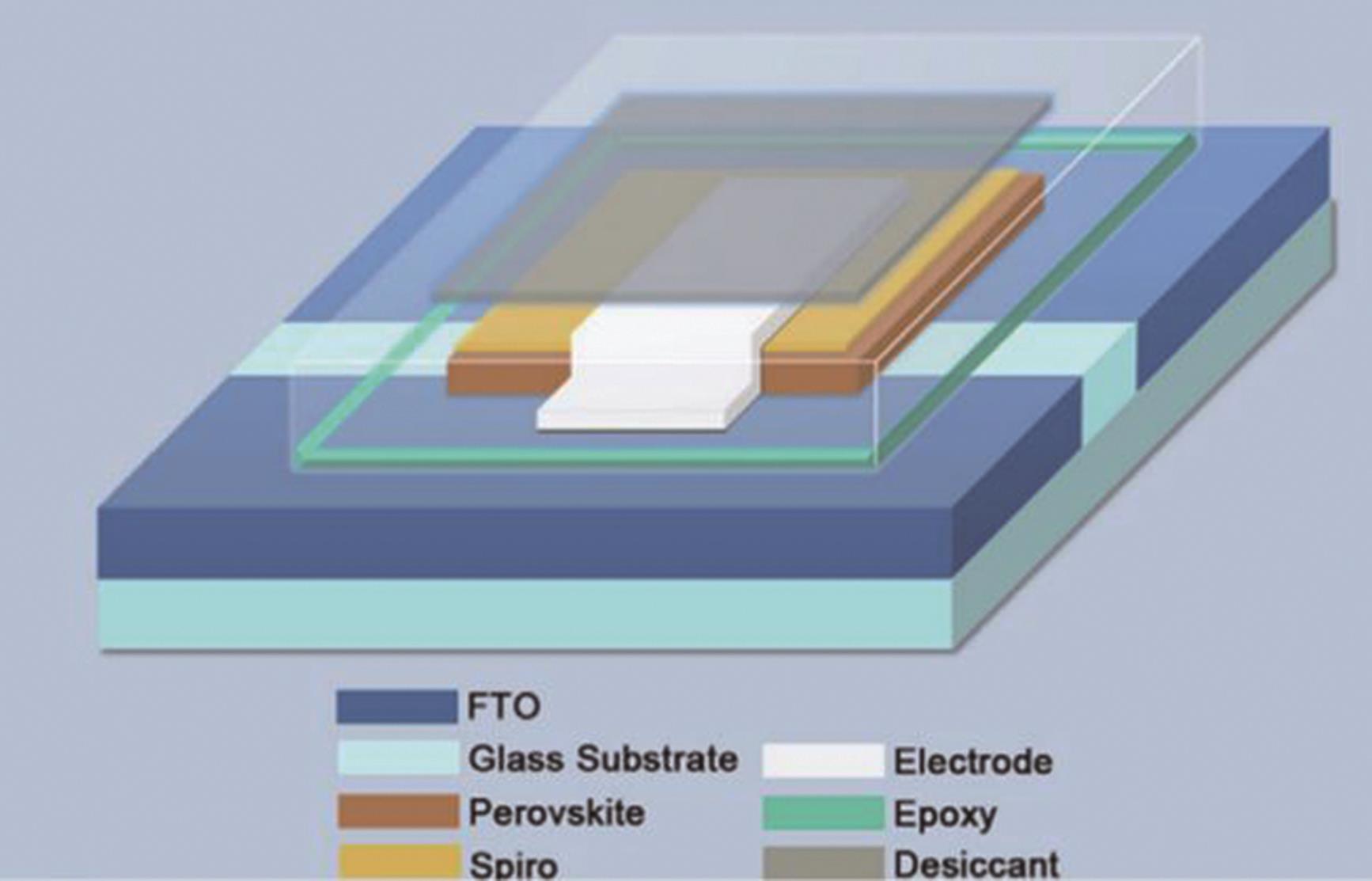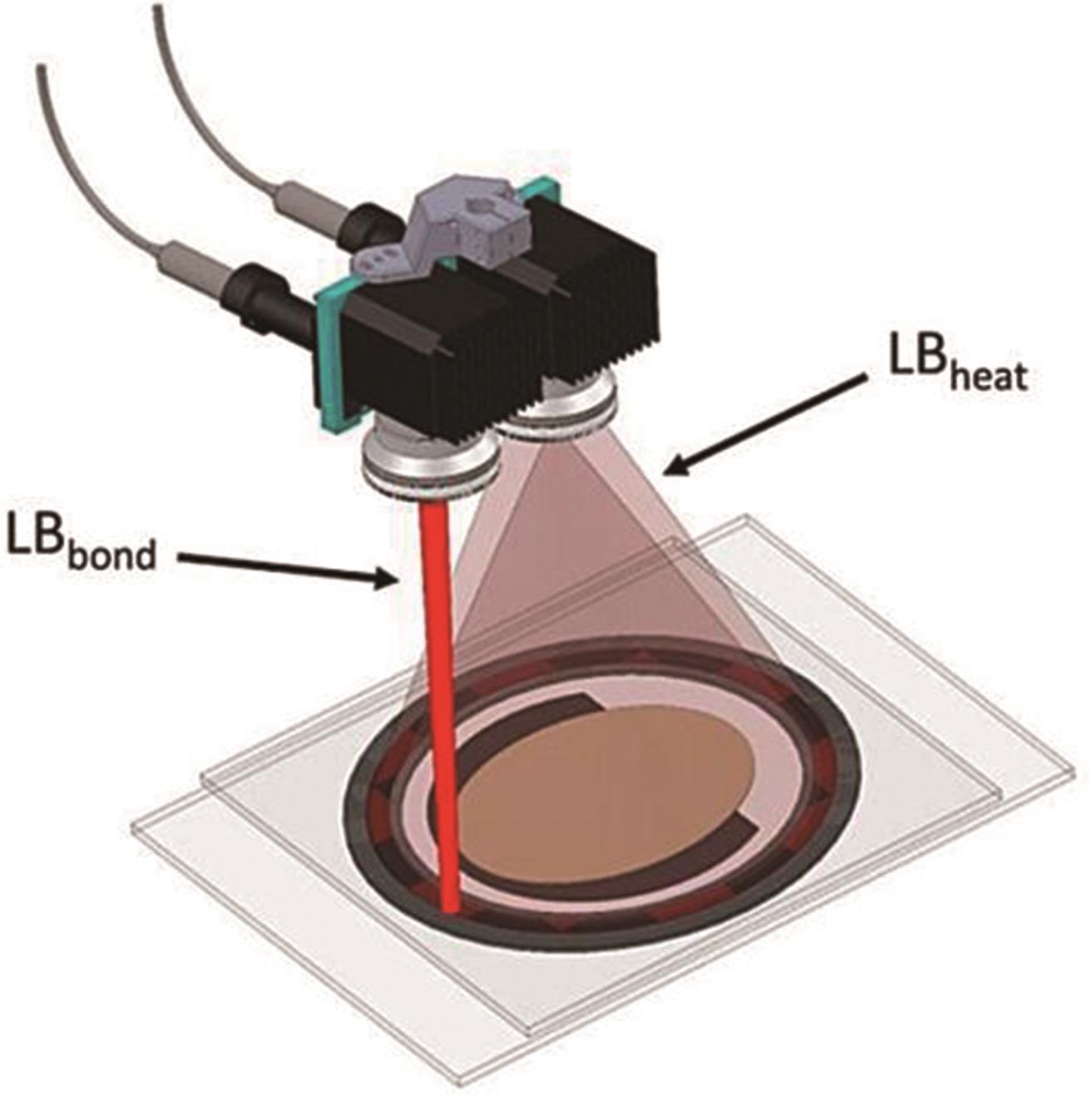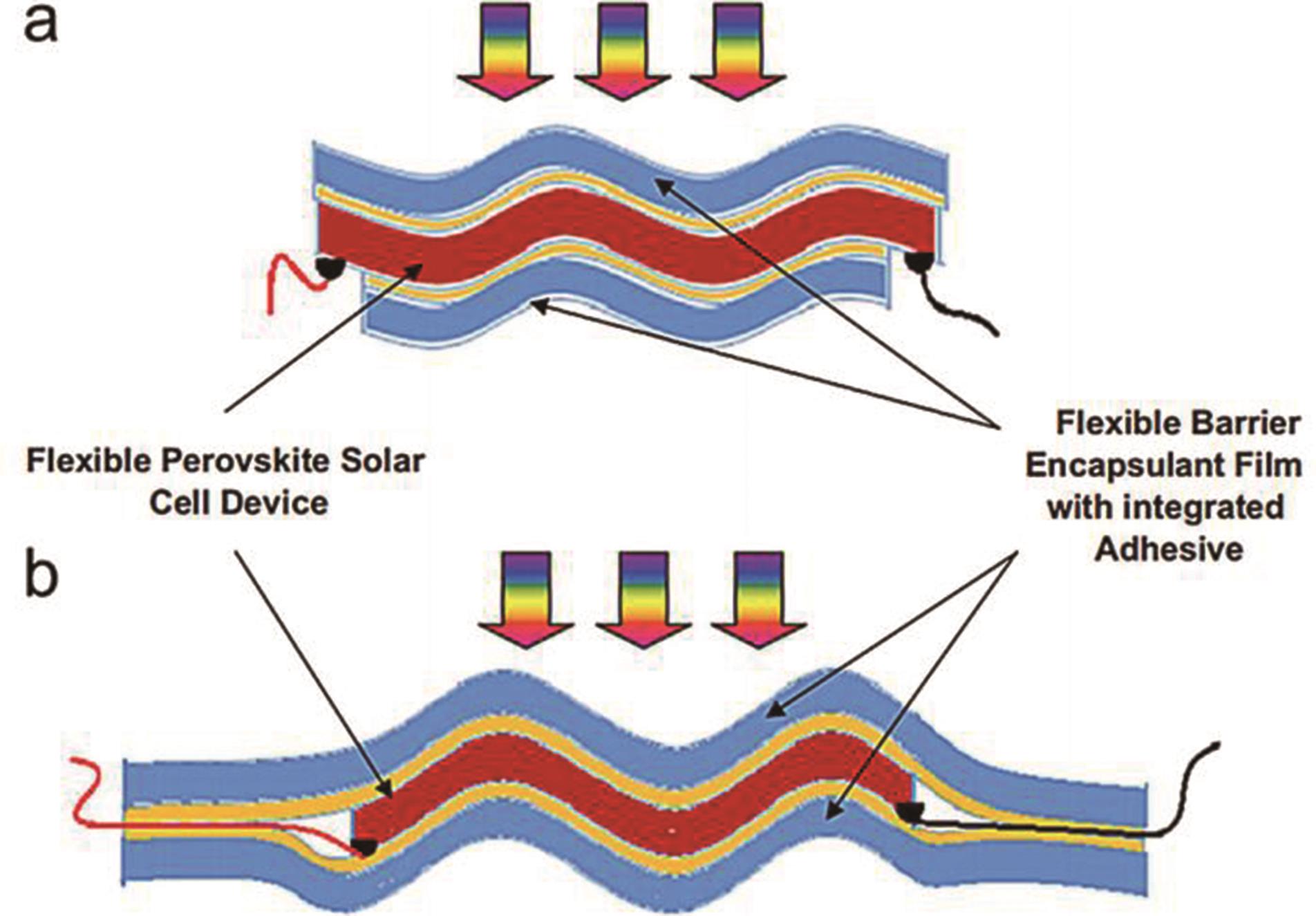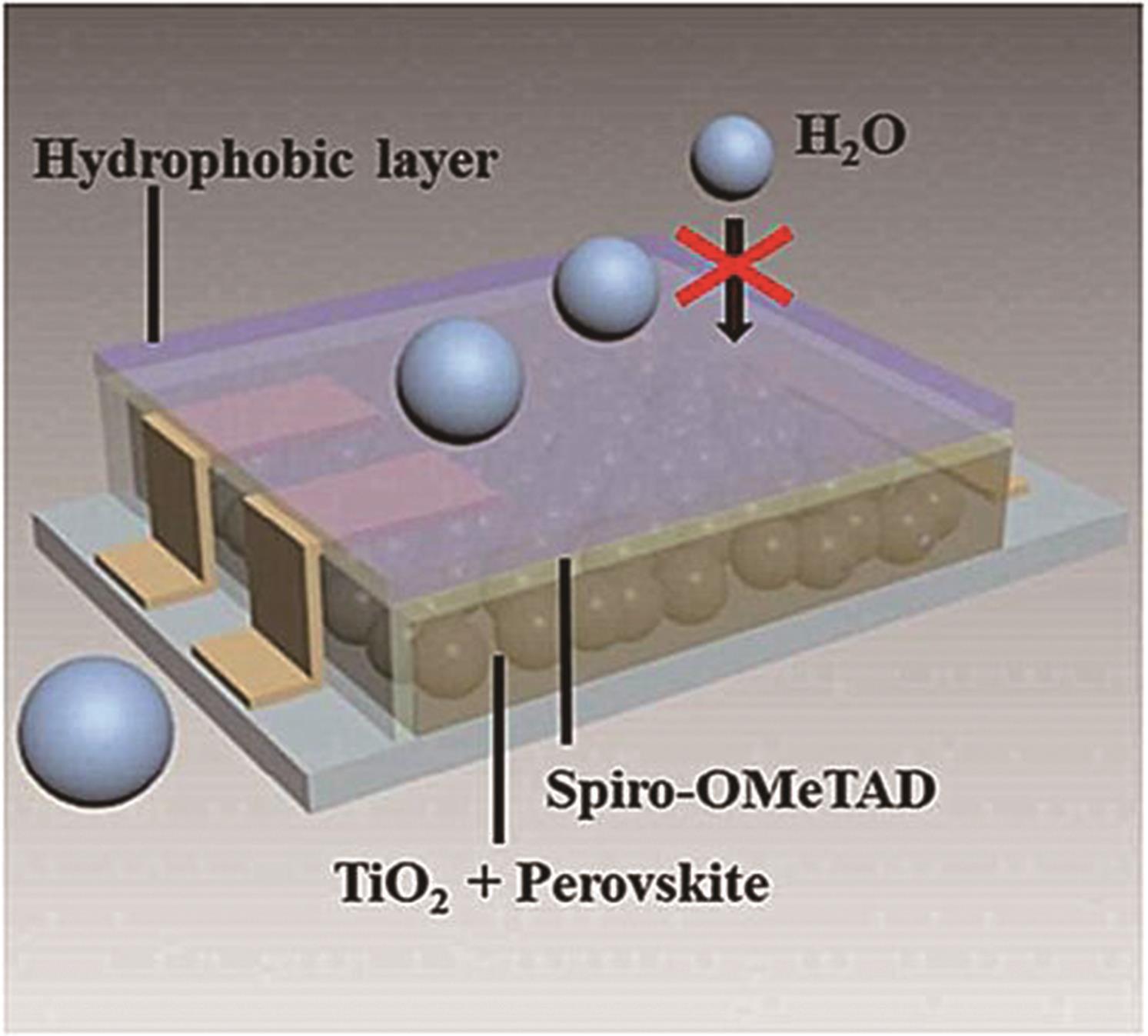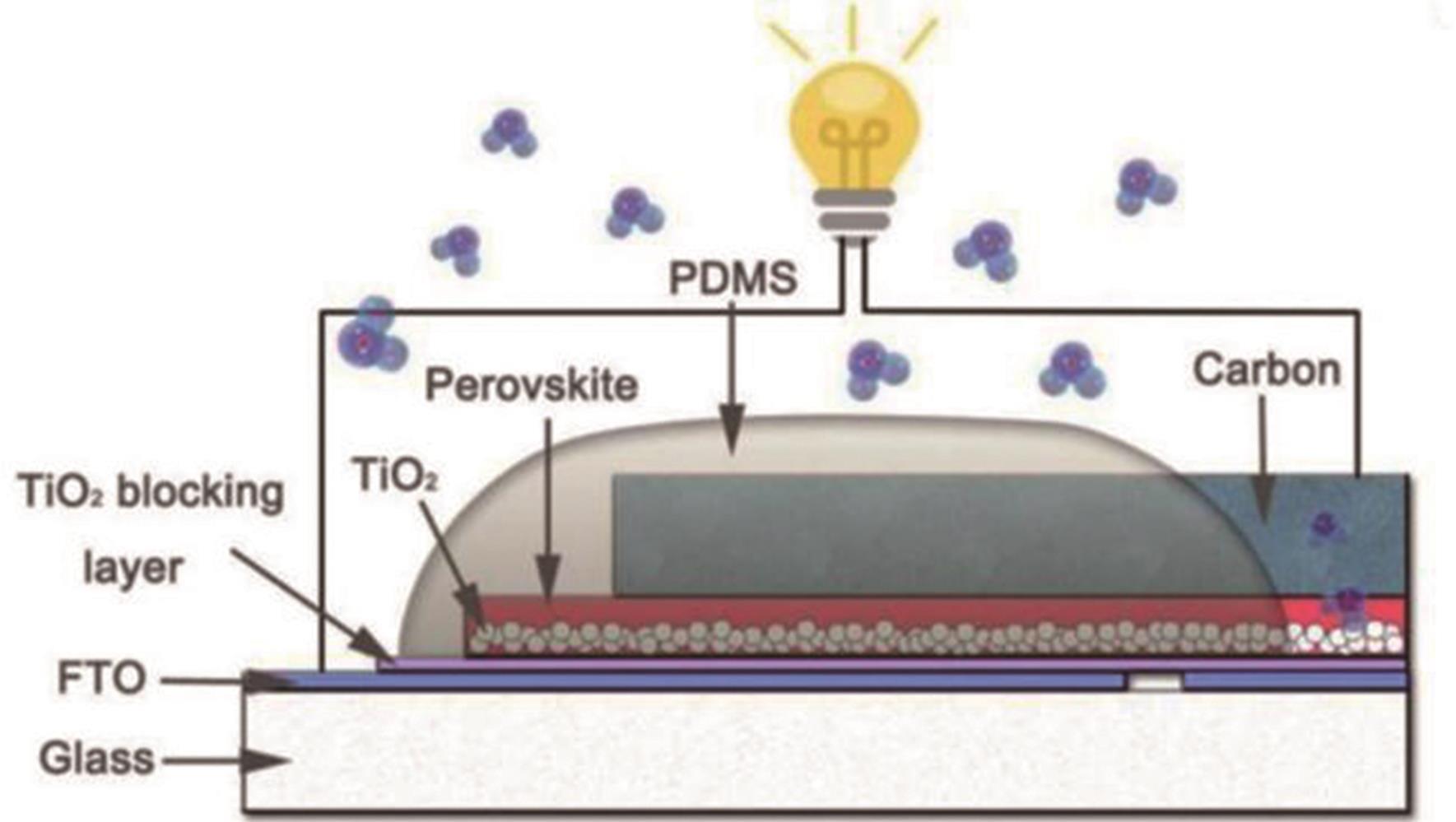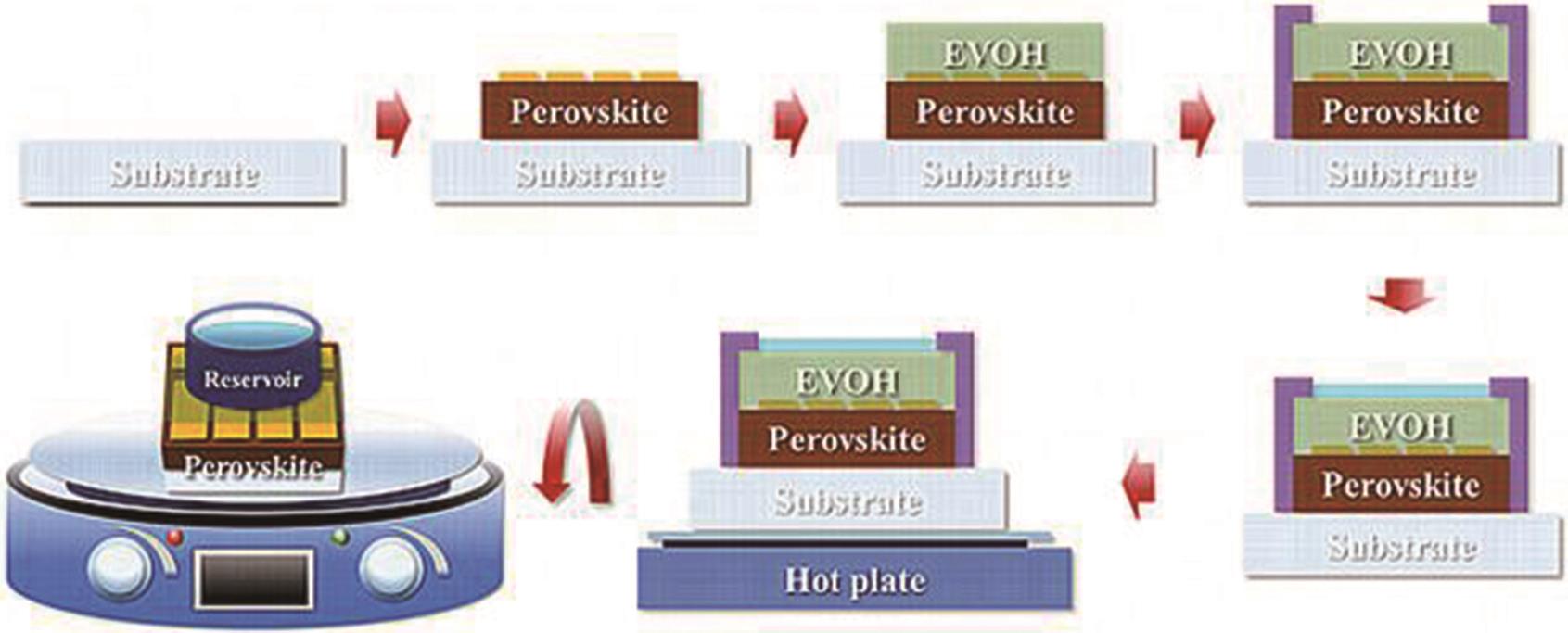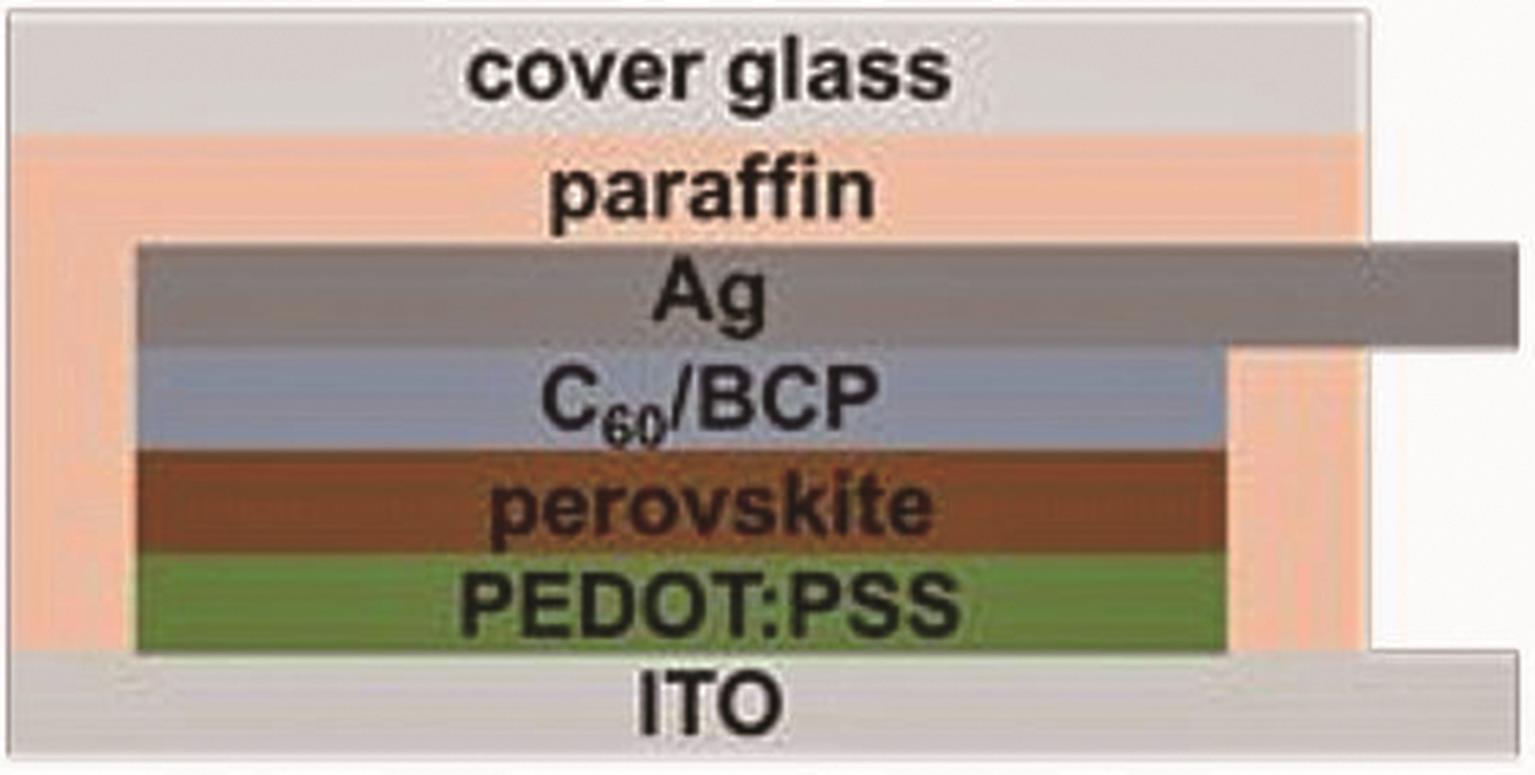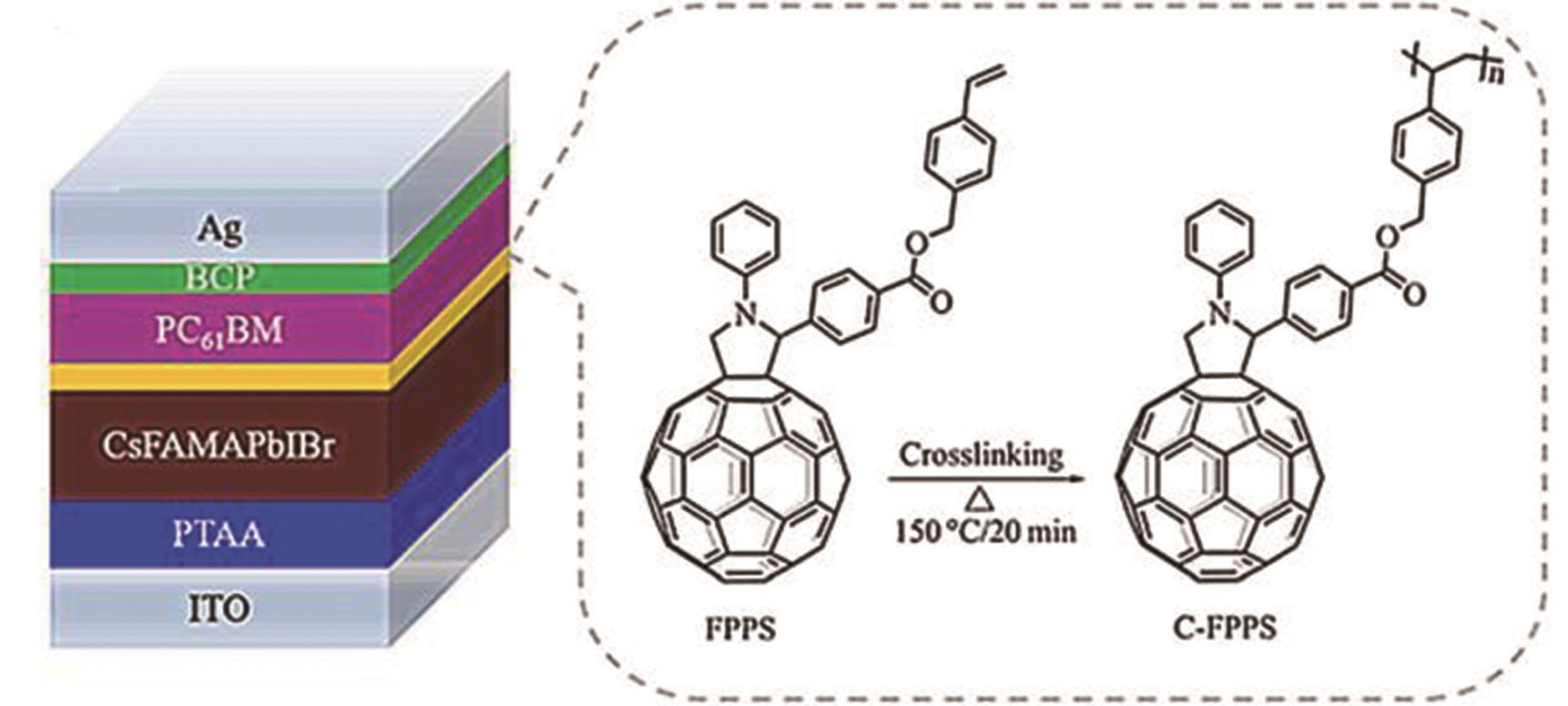
应用化学 ›› 2022, Vol. 39 ›› Issue (9): 1321-1344.DOI: 10.19894/j.issn.1000-0518.210521
• 综合评述 • 下一篇
钙钛矿光伏电池封装材料与工艺研究进展
王婷1,2, 魏奇1,2, 付强1,2, 李伟1( ), 王世伟1,2(
), 王世伟1,2( )
)
- 1.长春工业大学化学工程学院,长春 130012
2.长春工业大学材料科学高等研究院,长春 130012
-
收稿日期:2021-11-01接受日期:2022-02-22出版日期:2022-09-01发布日期:2022-09-08 -
通讯作者:李伟,王世伟 -
基金资助:国家自然科学基金(21204087);吉林省科技发展计划(20200403142SF);吉林省第十七批创新创业人才基金(2021Y002);长春市科技发展计划(21ZY39);吉林省教育厅产业化研究项目(JJKH20210766KJ)
Review of Perovskite Photovoltaic Cell Encapsulation Material and Technology
Ting WANG1,2, Qi WEI1,2, Qiang FU1,2, Wei LI1( ), Shi-Wei WANG1,2(
), Shi-Wei WANG1,2( )
)
- 1.College of Chemical Engineering,Changchun University of Technology,Changchun 130012,China
2.Advanced Research Institute of Materials Science,Changchun University of Technology,Changchun 130012,China
-
Received:2021-11-01Accepted:2022-02-22Published:2022-09-01Online:2022-09-08 -
Contact:Wei LI,Shi-Wei WANG -
About author:wswjldx2004@163.com
-
Supported by:the National Natural Science Foundation of China(21204087);Jilin Science and Technology Development Project(20200403142SF);the 17th Batch of Innovation and Entrepreneurship Talent Foundation of Jilin Province(2021Y002);Changchun Science and Technology Development Plan(21ZY39);Industrialization Research Project of the Education Department of Jilin Province(JJKH20210766KJ)
摘要:
钙钛矿太阳能电池作为第3代新概念太阳能电池,具有高光电转换效率、低成本和可柔性加工等优点,近年来发展迅速,其光电转换效率从一开始的3.8%增长到近期的25.5%,逐渐比肩硅电池,已接近商业化应用水平。目前,实现钙钛矿太阳能电池产业应用的关键环节在于电池封装,它不仅可以解决钙钛矿光伏器件稳定性问题,还可以实现电池安全、环保和延长使用寿命等要求。结合近十几年来钙钛矿光伏电池封装材料和封装工艺两方面的发展现状,文中介绍了钙钛矿电池封装领域取得的成果和存在的不足,讨论了目前现有封装技术的优缺点,以及它们适用的不同器件类型。着重在不同温度湿度条件下,比较了不同封装材料性能、封装工艺条件对钙钛矿电池效率及稳定性的影响,归纳出影响钙钛矿电池薄膜封装效果的3个关键因素: 聚合物的弹性模量、水蒸气透过率、加工温度。比较了不同聚合物薄膜封装材料适宜的加工温度、优缺点及加工成本。可以看出,随着钙钛矿光伏电池工业化需求的强烈增长和人们对其封装材料研究的不断深入,研究适合大面积生产和光伏建筑一体化的新型功能聚合物封装材料将是必然趋势。
中图分类号:
引用本文
王婷, 魏奇, 付强, 李伟, 王世伟. 钙钛矿光伏电池封装材料与工艺研究进展[J]. 应用化学, 2022, 39(9): 1321-1344.
Ting WANG, Qi WEI, Qiang FU, Wei LI, Shi-Wei WANG. Review of Perovskite Photovoltaic Cell Encapsulation Material and Technology[J]. Chinese Journal of Applied Chemistry, 2022, 39(9): 1321-1344.

图1 (a)n-i-p结构平面PSC; (b)p-i-n结构平面PSC; (c)介孔PSC
Fig.1 (a)n-i-p planar perovskite solar cell; (b)p-i-n planar perovskite solar cell; (c)Mesoporous perovskite solar cell
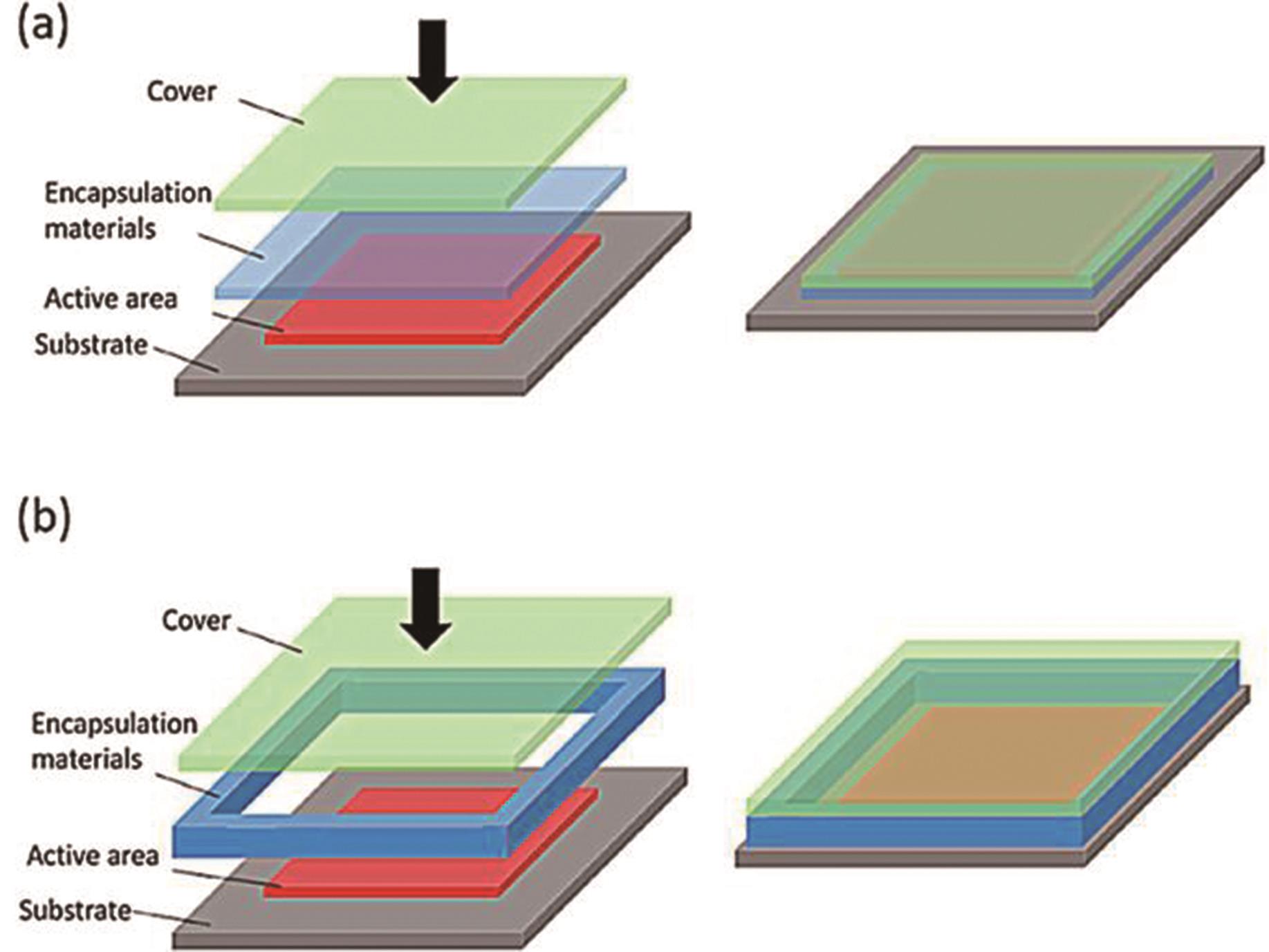
图2 (a)保护层作为封装材料覆盖活性区; (b)将密封胶置于在活性区边缘[56]
Fig.2 (a)Protective layer as encapsulation materials covers the active area; (b)The sealant is placed on the edge of the active area[56]
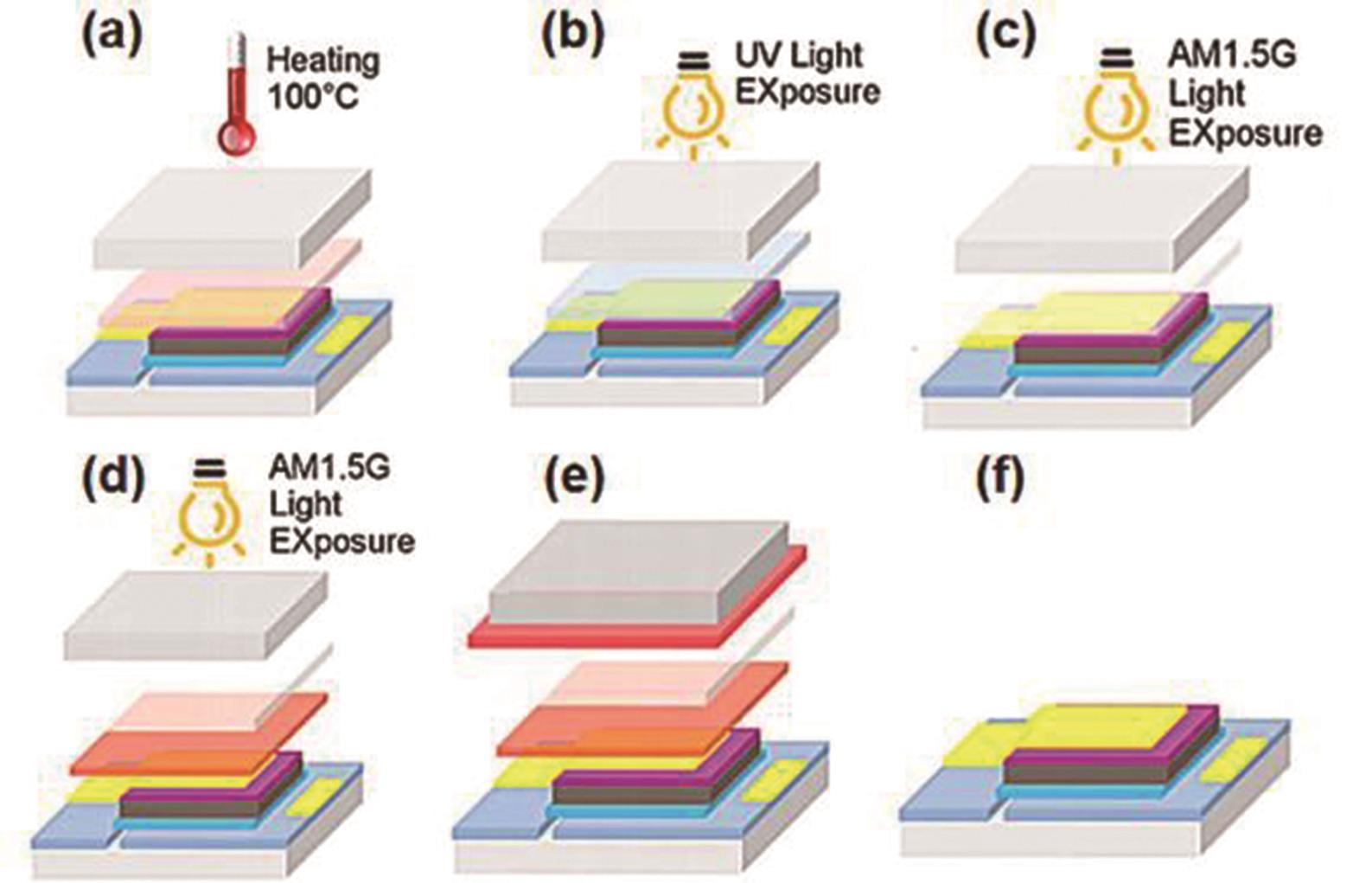
图3 (a)使用热塑型密封胶(Surlyn60)封装; (b)使用紫外线固化胶(Threebond)封装; (c)使用可光固化胶封装; (d)使用聚酰亚胺胶带封装和可光固化胶封装; (e)使用聚酰亚胺胶带作为一次密封,UV固化胶-玻璃作为二次密封,Threebond粘合剂作为边缘密封; (f)未封装空白样[62]
Fig.3 (a)Package with thermoplastic sealant(Surlyn60); (b) Package with ultraviolet curing adhesive(Three bond); (c) Package with UV curable adhesive; (d) Package with polyimide tape and UV curable adhesive; (e) Use polyimide tape as primary seal, UV curable adhesive glass as secondary seal, and the most additional edge seal of three adhesive; (f) Unpacked blank sample[62]

图4 通过3种方法(不按比例)封装的PSC,FTO玻璃侧的横截面示意图和平面图[63]
Fig.4 Cross-sectional schematics and plan-view photographs from the FTO glass side of PSCs encapsulated by three methods(not to scale)[63]
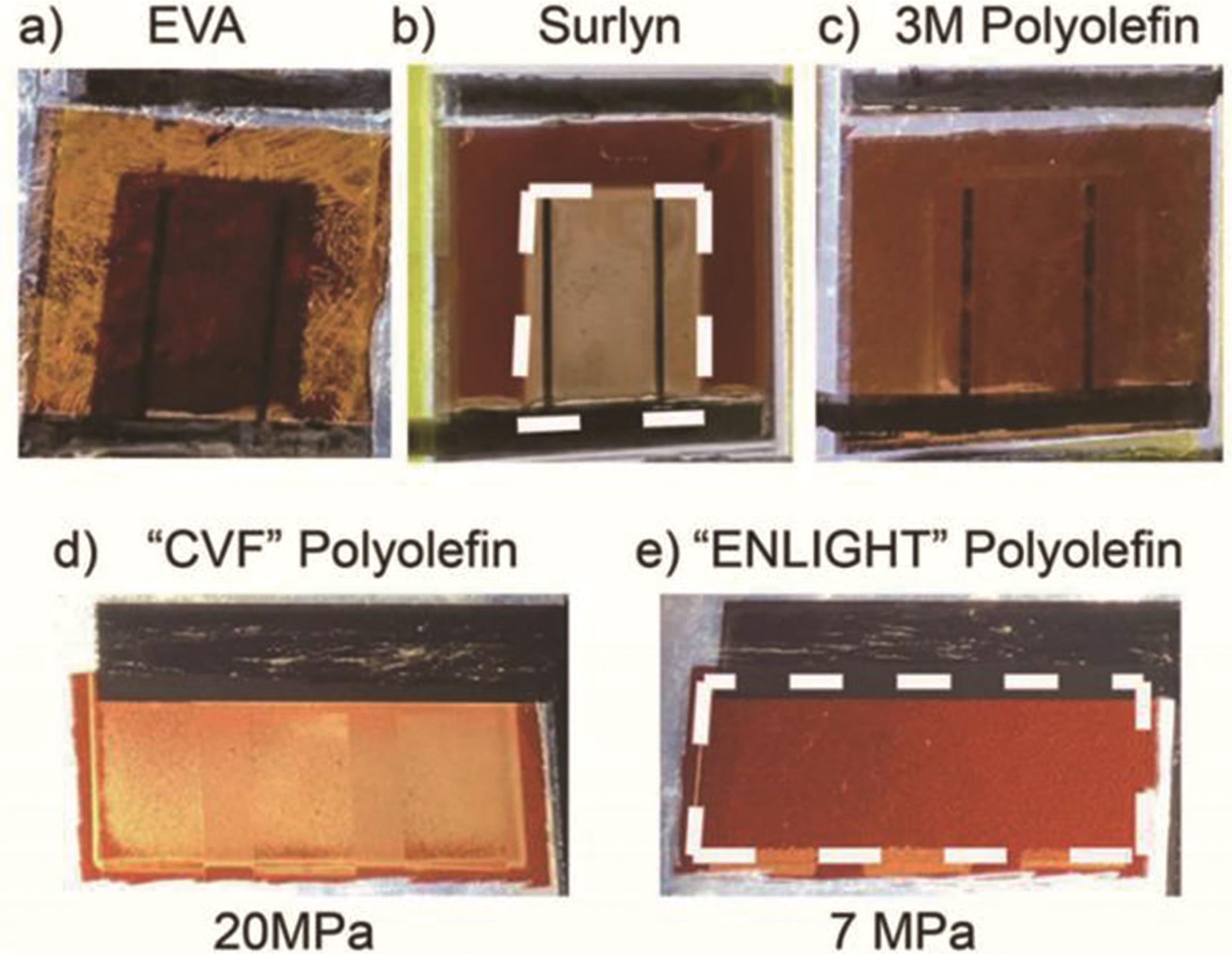
图5 在120 ℃,相对湿度100%的条件下20 h后,第1代封装PSC在太阳能灯下拍摄的照片(a)EVA; (b) Surlyn; (c) 3M聚烯烃。另一组为在85 ℃老化1024 h后,第2代封装PSC在太阳能灯下拍摄的照片(d)弹性模量为20 MPa的“CVF”聚烯烃(e)弹性模量为7 MPa的“ENLIGHT”聚烯烃,顶部保护性ITO在(b)和(e)中以虚线矩形表示[64]
Fig.5 Pictures taken under a solar lamp of the 1st generation encapsulated PSCs in (a) Ethylene Vinyl Acetate(EVA) ; (b) Surlyn; (c) 3M′s Polyolefin after 20 hours at 120 ℃-100% relative humidity. Another set of pictures taken under the lamp of the 2nd generation encapsulated PSCs in (d) “CVF” Polyolefin with 20 MPa elastic modulus and (e) “ENLIGHT” Polyolefin with 7 MPa elastic modulus after 1024 h aging at 85 ℃ in ambient. The top protective ITOs are outlined in (b) and (e) as dash rectangles[64]
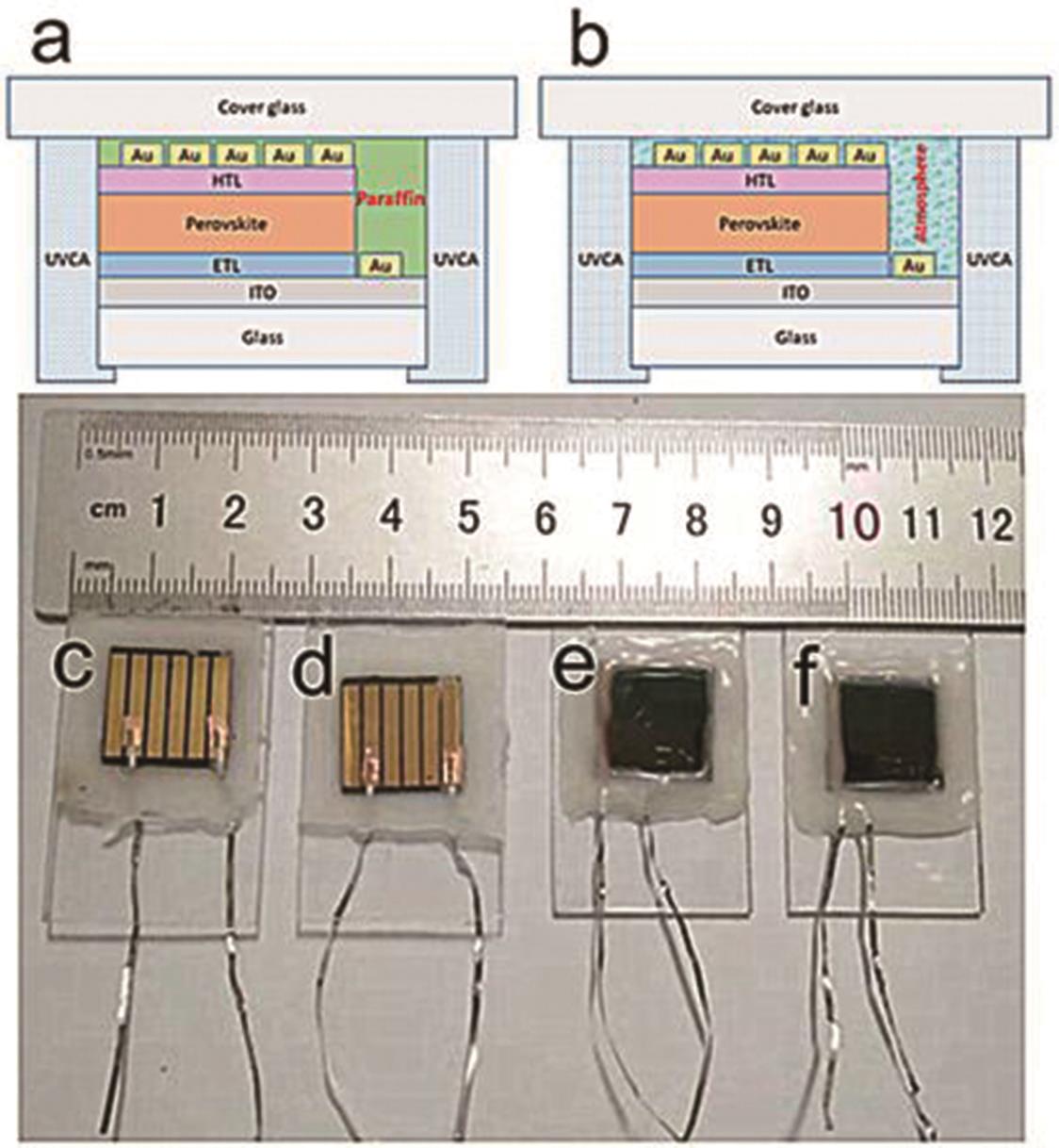
图7 封装结构示意图(a)含有石蜡的UV固化胶粘剂(UVCA); (b)不含石蜡的UVCA;含有石蜡的UVCA封装的设备的双面照片(c)和(e),不含石蜡的UVCA封装装置的双面照片(d)和(f)[68]
Fig.7 The schematic of encapsulation structure of (a) UVCA with paraffin and (b) UVCA without paraffin. The two-sided photo-image of device encapsulated by UVCA with paraffin of (c) and (e). The two-sided photo-image of device encapsulated by UVCA without paraffin of (d) and (f)[68]
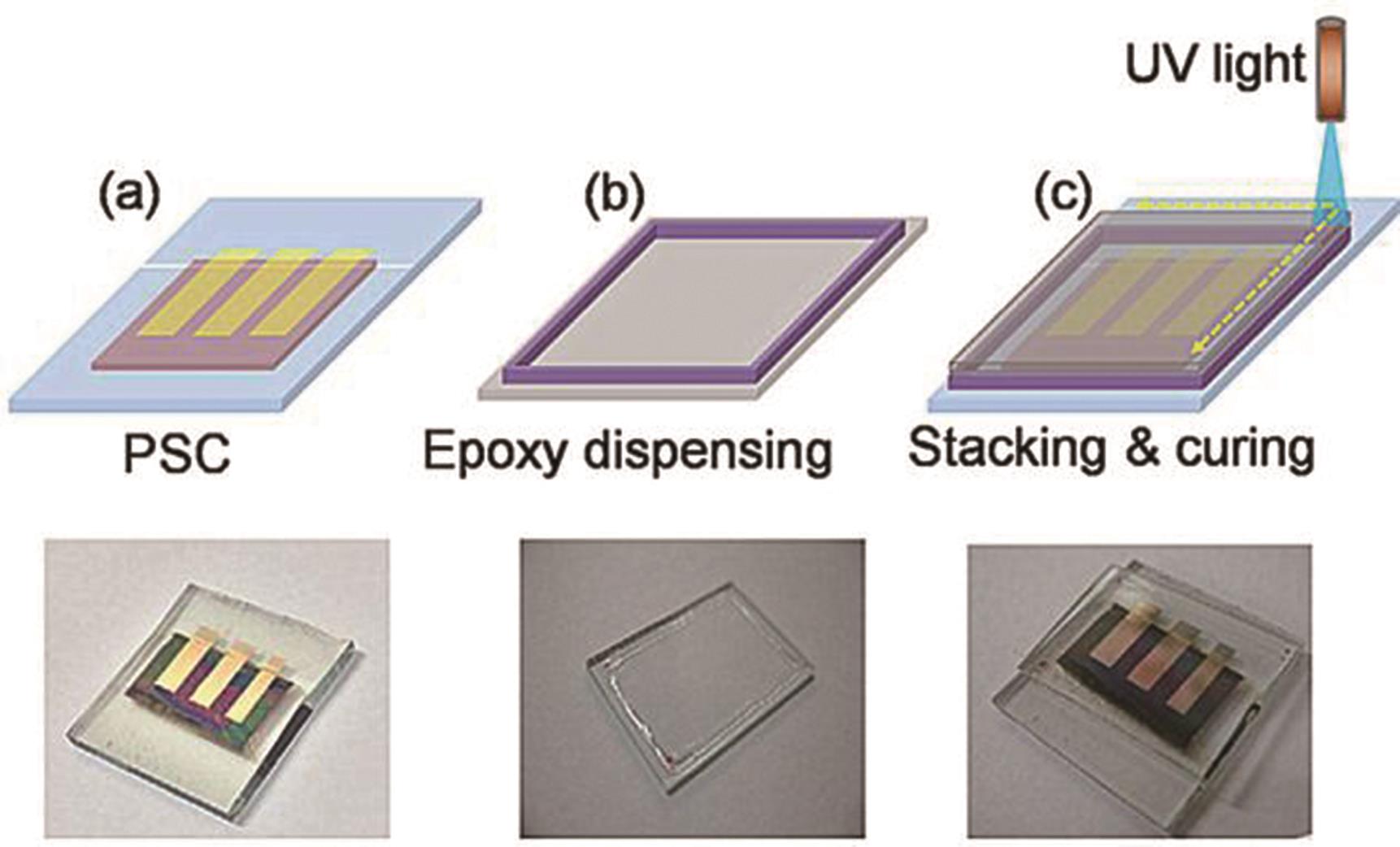
图8 PSC玻璃-玻璃封装的示意图(顶行); (a) FTO玻璃基板上的钙钛矿型太阳能电池; (b)带有环氧封边胶的覆盖玻璃; (c)堆叠和UV固化,各阶段的实际照片见第2行[69]
Fig.8 Schematic illustration(top row)of glass-to-glass encapsulation of perovskite solar cell; (a) Perovskite solar cell on FTO glass substrate; (b) Epoxy edge sealant dispensed cover glass; (c) Stacking and UV curing. Actual photographs at respective stages are shown in the bottom row[69]

图11 (a)钙传感器(左)和PSC(右),钙传感器测试装置的结构为玻璃/ITO/钙传感器/粘合剂/屏障,PSC的结构为玻璃/ITO/SnO2/Al2O3/MAPbI3/Spiro-OMeTAD/Au/粘合剂/屏障。测试了不同的屏障,包括PET、玻璃和超高渗透屏障膜(UHPBF); (b)柔性PET、UHPBF-R、UHPBF-S屏障和刚性玻璃屏障的照片; (c) PET/ZTO/ORMOCER/ZTO(UHPBF-R)和(d) PEN/ZTO/ORMOCER/ZTO/ORMOCER/ZTO/ORMOCER/ZTO/SiO x C y Hz(UHPBF-S)屏障的扫描电子显微镜(SEM)[82]
Fig.11 (a) Layouts used to measure the degradation of calcium sensors (left) and perovskite solar cells (PSC, right). Calcium test devices had an architecture of glass/ITO/calcium/adhesive/barrier, and PSCs had a structure of glass/ITO/SnO2/Al2O3/MAPbI3/Spiro-OMeTAD/Au/adhesive/barrier. Different barriers were tested including PET, glass, and ultra-high permeation barrier films(UHPBF). (b) Photograph of flexible PET, UHPBF-R, and UHPBF-S barriers, and rigid glass barrier. Scanning electron microscopy (SEM) of (c) PET/ZTO/ORMOCER/ZTO (UHPB F-R) and (d) PEN/ZTO/ORMOCER/ZTO/ORMOCER/ZTO/SiO x C y Hz (UHPBF-S) barriers[82]
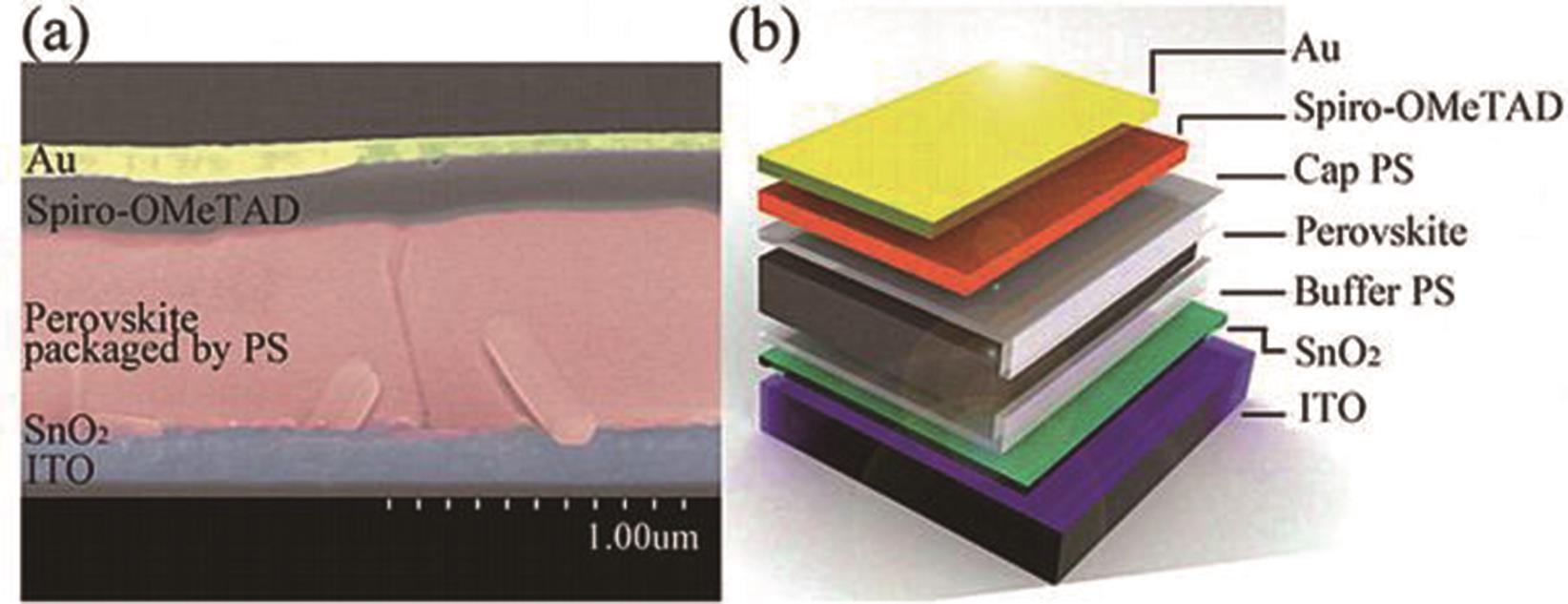
图12 (a)钙钛矿电池的横截面扫描电子显微镜图像; (b) PSCs封装内部结构示意图[84]
Fig.12 (a) Cross-sectional SEM image of the perovskite cell; (b) Schematic diagram of inner-encapsulated PSCs′ structure[84]

图14 (a)可打印PSC采用热熔胶膜和玻璃的封装方案; (b)封装电池[89]
Fig.14 (a) The scheme of the encapsulation of printable PSCs based on hot melt films and glass sheets; (b) The digital images of the encapsulated cells[89]
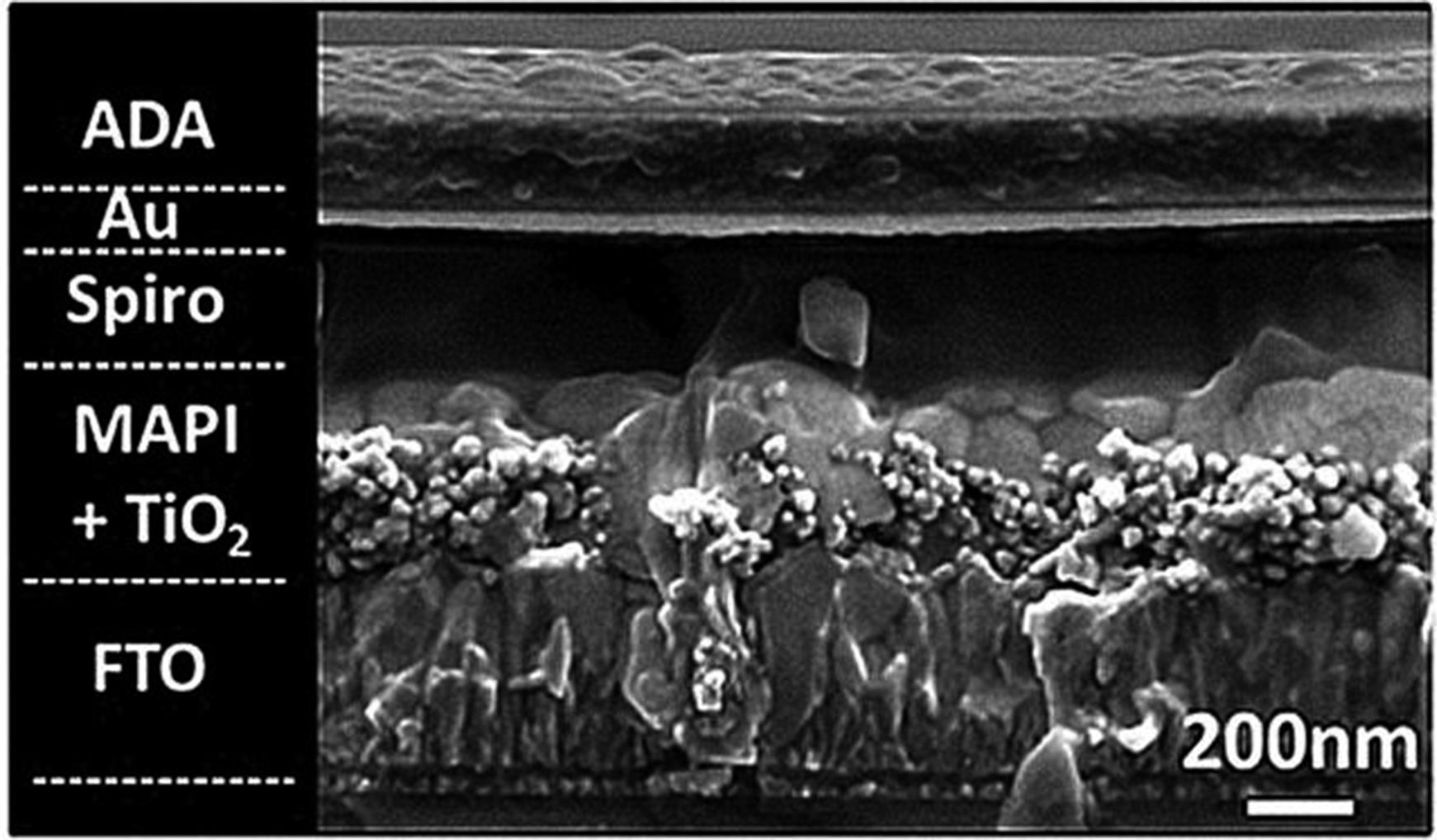
图15 封装的(FTO/cTiO2/mTiO2/MAPI/Spiro-OMeTAD/Au/ADA)器件的横截面扫描电子显微镜图像[91]
Fig.15 Representative cross-sectional SEM image of an encapsulated (FTO/cTiO2/mTiO2/MAPI/Spiro-OMeTAD/Au/ADA) devices[91]
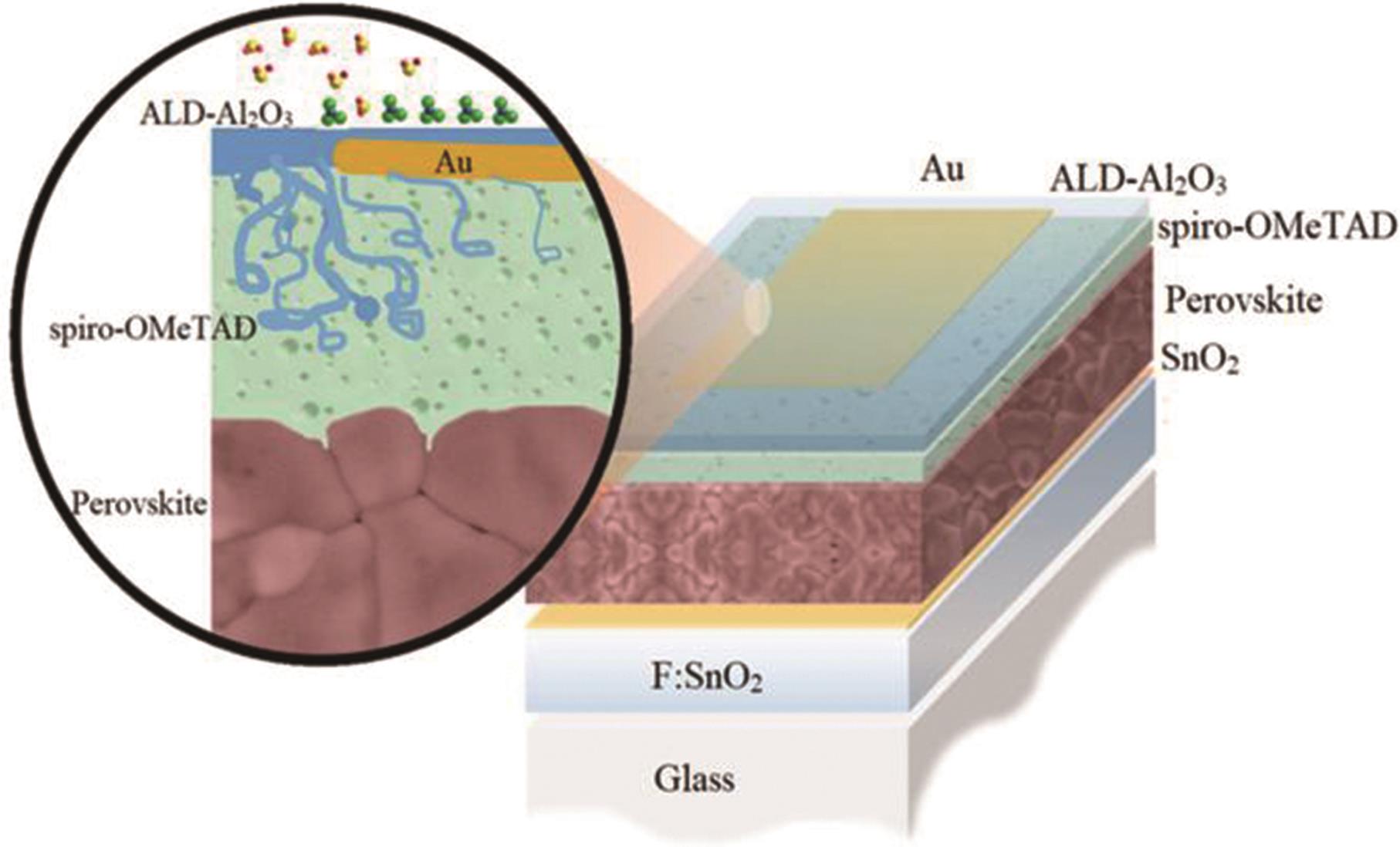
图22 以30 nm ALD-Al2O3为封装材料的三阳离子混合卤化物钙钛矿装置示意图[99]
Fig.22 Schematic of triple cations mixed halide based perovskite devices with 30 nm ALD-Al2O3 on top of gold act as encap-sulant[99]
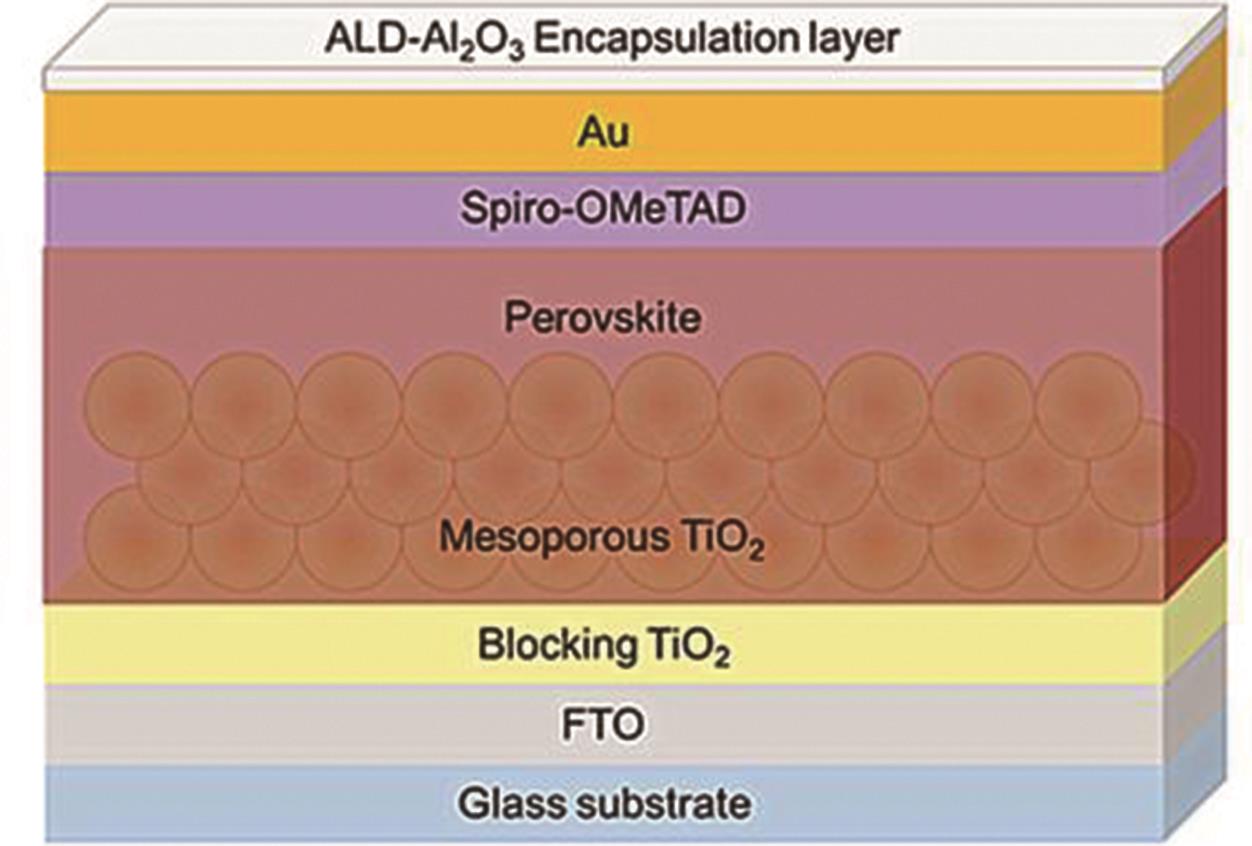
图23 FTO/bl-TiO2/mp-TiO2/MAPbI3/Spiro-OMeTAD/Au体系结构示意图; ALD-Al2O3封装层(不按比例)[101]
Fig.23 Schematic of the FTO/bl-TiO2/mp-TiO2/MAPbI3/Spiro-OMeTAD/Au architecture with the ALD-Al2O3 encapsulation layer proposed in this work (not to scale)[101]
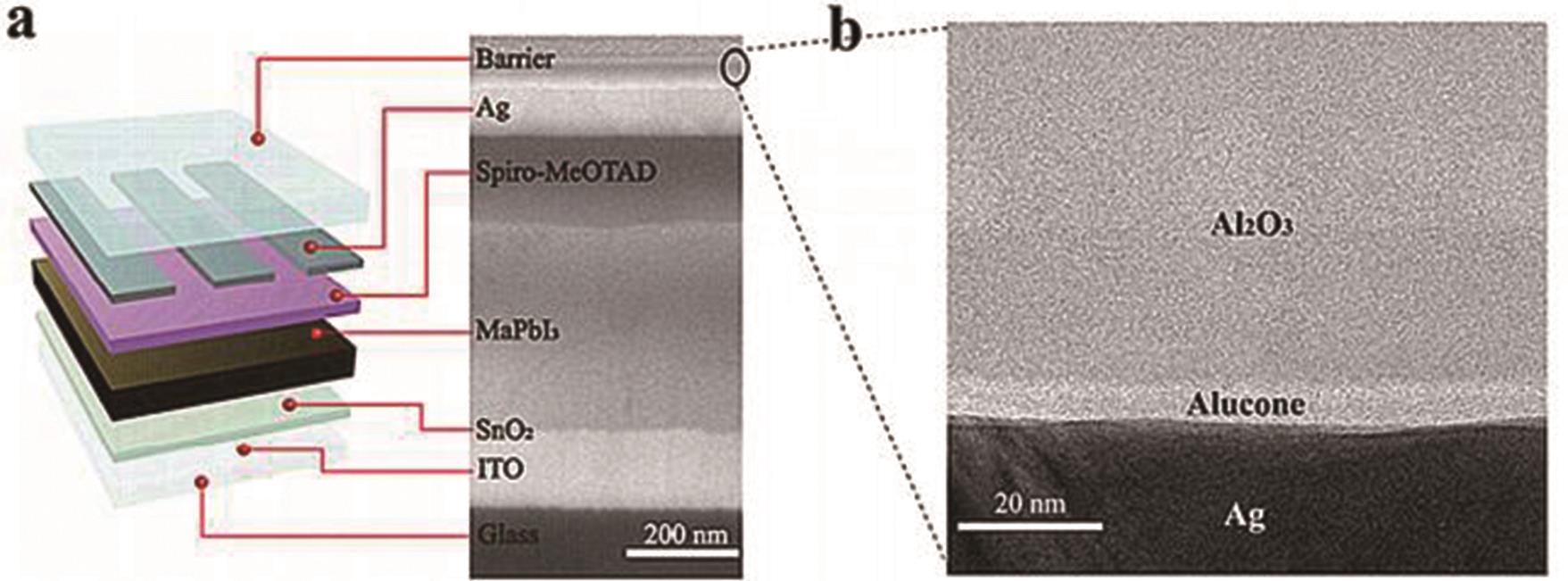
图24 (a)PSC的结构示意图和带封装层的PSC的横截面扫描电子显微镜图像; (b)PSC上屏障层的透射电子显微镜图像[103]
Fig.24 (a) Structure schematic diagram of the perovskite solar cell and cross-section SEM image of perovskite solar cell with the encapsulation layer; (b) TEM image of the barrier layer on the perovskite solar cells[103]

图25 (a)PVP/环氧树脂封装的PSC的制造和测试示意图; (b)装置结构显示所有层及其近似厚度[104]
Fig.25 (a) A schematic of the fabrication and testing routine used to create perovskite solar cells incorporating a PVP/epoxy encapsulation; (b) Device architecture showing all layers, together with their approximate thicknesses[104]

图26 (右)封装的PSC示意图; (左)薄膜封装的横断面扫描电子显微镜图像[105]
Fig.26 (Right) Schematic illustration of the encapsulated PSC and (left) the cross-sectional SEM image of the TFE[105]

图27 (a)PSC器件结构及钙钛矿分解说明; (b)PSC封装层的保护机制及单复合层和双复合封装层的层结构[107]
Fig.27 (a) Device structure of perovskite solar cells and illustration of perovskite decomposition; (b) Protection mechanism of encapsulation layers in perovskite solar cells and the layer structures of single composite and double composite encapsulation layers[107]
聚合物封装材料 Polymer encapsulation materials | 封装温度 Encapsulation temperature/℃ | 成本 Cost($/kg) | 参考文献 Ref. |
|---|---|---|---|
| PIB | 90~160 | 0.22~6.8 | [ |
| EVA | 140~150 | 3.3~4.7 | [ |
| Surlyn | 140 | 7.06(Surlyn DuPont 1702?1) | [ |
| POE | 150 | 1.85(DuPont 8150) | [ |
| UV curable resin | 20 | 145 | [ |
| TPU | 80~140 | 4.87(TPU 460 Bayer) | [ |
表1 不同聚合物封装材料对比
Table 1 Comparison of different polymer packaging materials
聚合物封装材料 Polymer encapsulation materials | 封装温度 Encapsulation temperature/℃ | 成本 Cost($/kg) | 参考文献 Ref. |
|---|---|---|---|
| PIB | 90~160 | 0.22~6.8 | [ |
| EVA | 140~150 | 3.3~4.7 | [ |
| Surlyn | 140 | 7.06(Surlyn DuPont 1702?1) | [ |
| POE | 150 | 1.85(DuPont 8150) | [ |
| UV curable resin | 20 | 145 | [ |
| TPU | 80~140 | 4.87(TPU 460 Bayer) | [ |
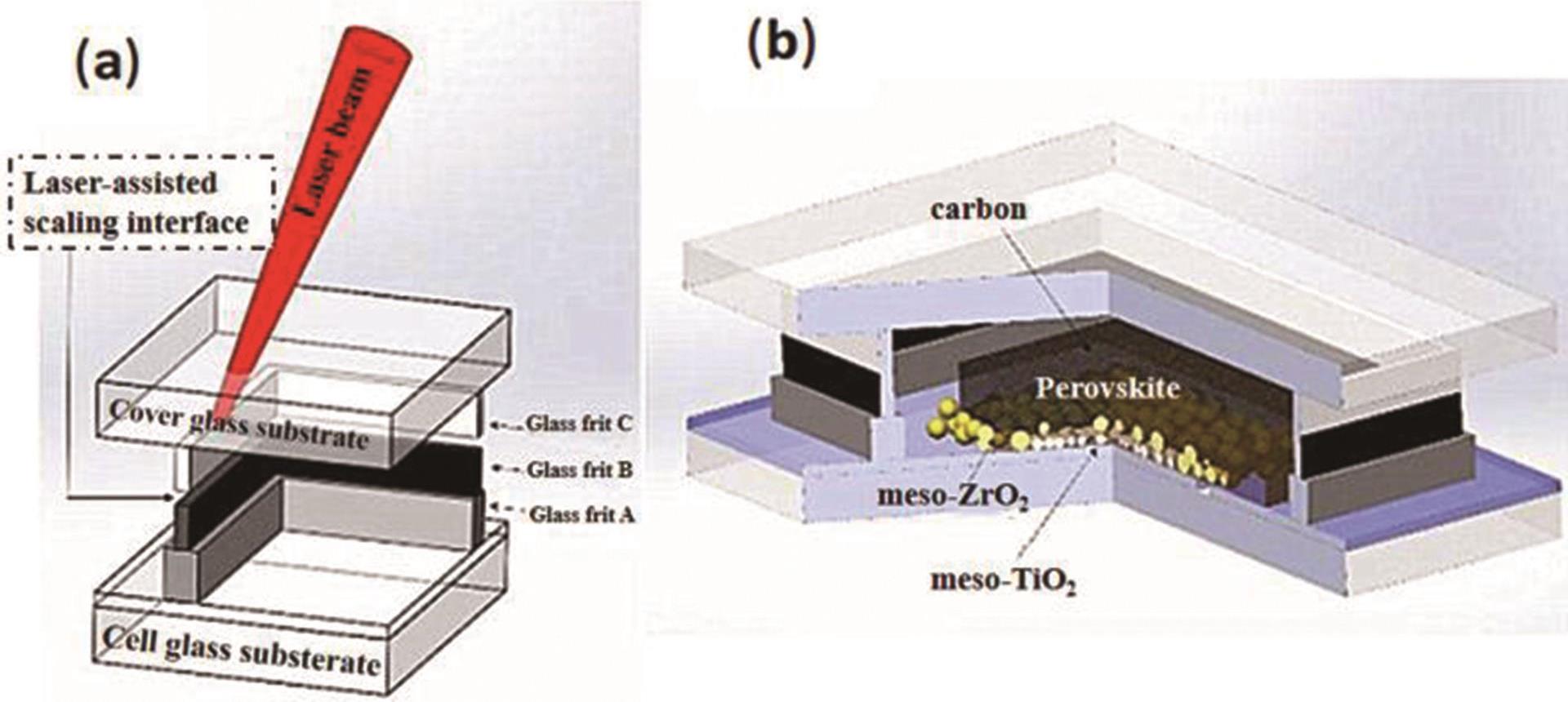
图28 (a)三层玻璃激光辅助密封结构; (b)封装无HTM PSC装置示意图[112]
Fig.28 Schematic view of (a) the triple layer glass frit laser assisted sealing configuration and (b) encapsulated HTM-free PSC device[112]
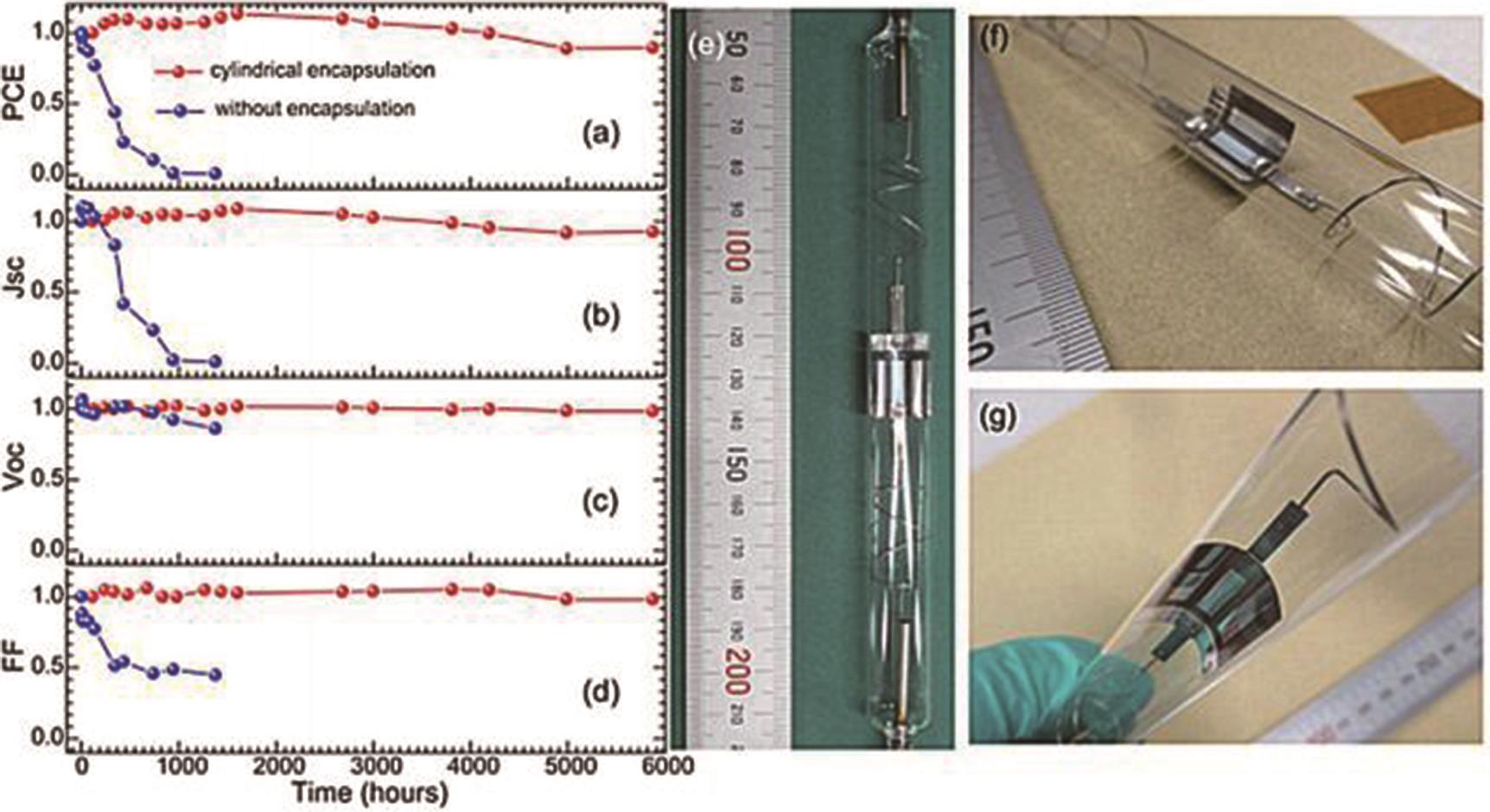
图29 圆柱形封装和未封装柔性PSCs的长期稳定性试验(a-d)从不同角度拍摄圆柱形封装的装置照片(e-g)[114]
Fig.29 Long-term stability test of the flexible PSCs left in encapsulated in cylindrical type and without encapsulation(a-d). Photographs of the cylindrical type encapsulated device from different angles(e-g)[114]
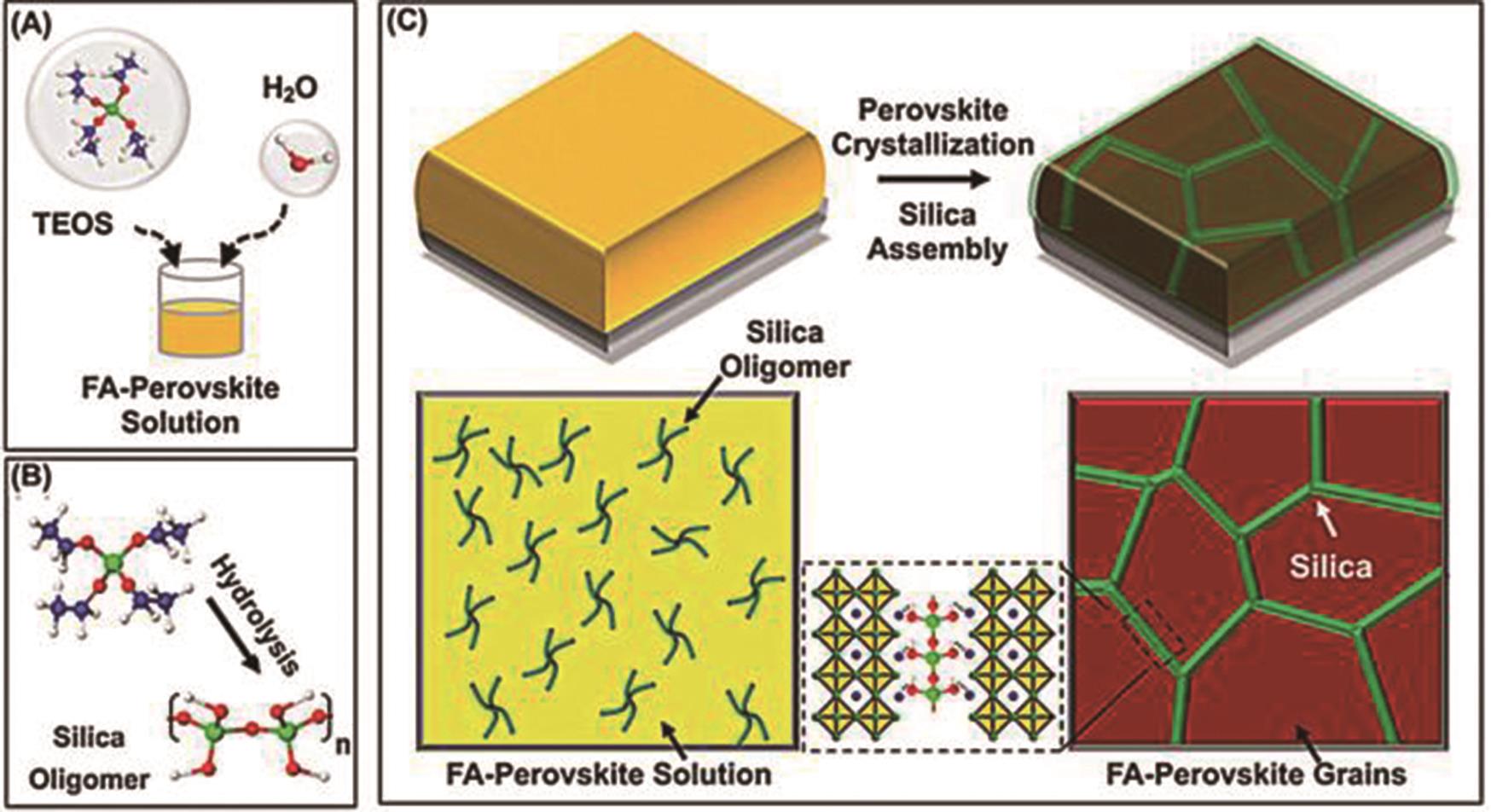
图30 (A)在“一锅”中混合FA基钙钛矿前驱体溶液和二氧化硅前驱体; (B)通过正硅酸乙酯与水的水解反应形成二氧化硅低聚物; (C)FA基钙钛矿薄膜的形成过程,该薄膜由包含前体溶液的二氧化硅低聚物中的单个二氧化硅包裹颗粒组成[115]
Fig.30 Schematic illustration showing (A) the mixing of the FA-based perovskite precursor solution and the silica precursors in “one pot”, (B) the formation of silica oligomers via the hydrolysis reaction of TEOS with water and (C) the formation process of the FA-based perovskite film consisting of individual silica-encapsulated grains from the silica-oligomers-containing precursor solution[115]
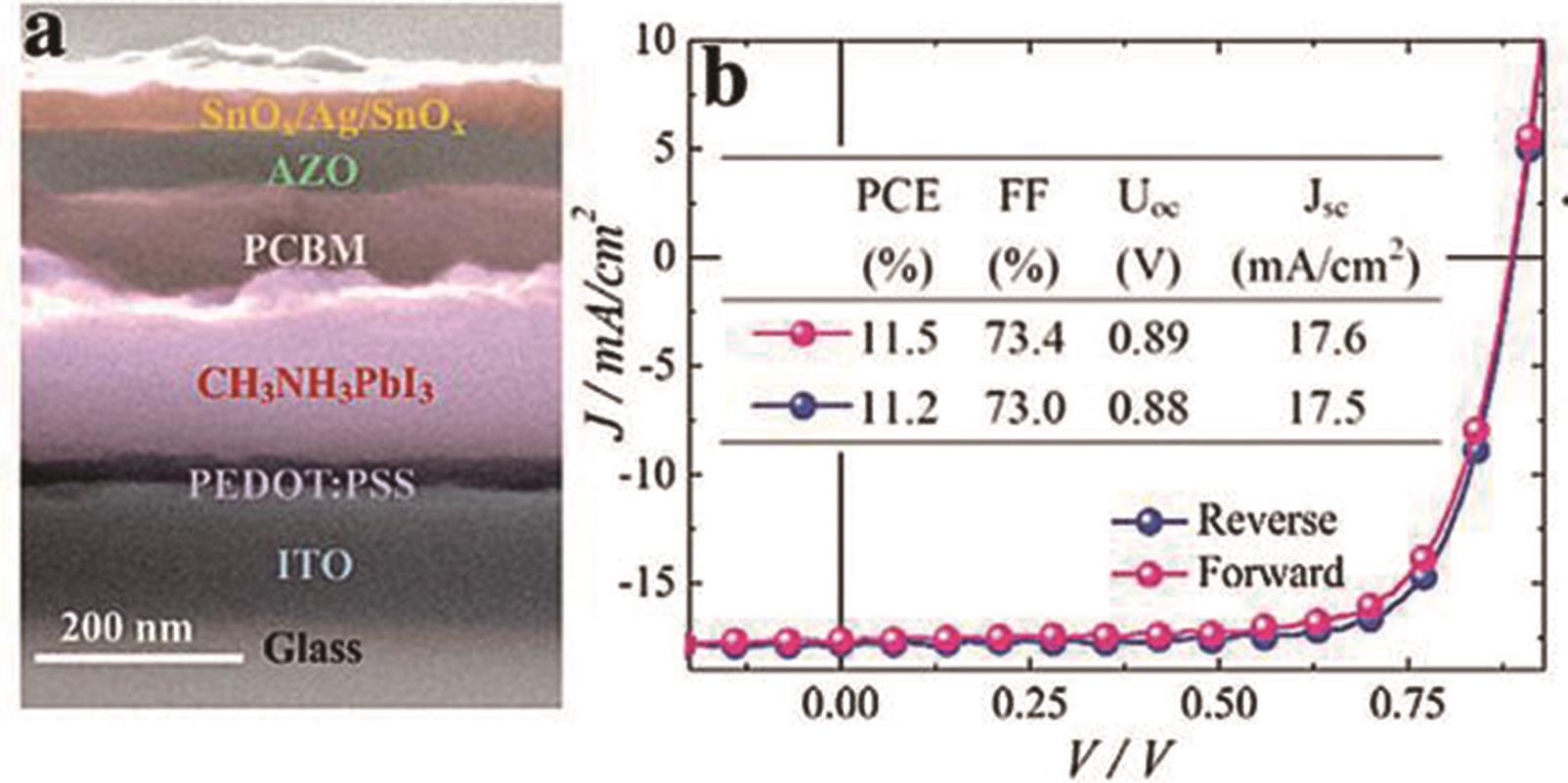
图31 (a)半透明太阳能电池横截面的SEM图像; 层顺序为: 玻璃/ITO/PEDOT:PSS/MAPbI3/PCBM/AZO/SnO x /Ag/SnO x; (b)正向和反向测量的典型J-V特性,已使用外部量子效率(EQE)数据对AM1.5光源光谱失配的电流密度值进行了校正,插图为相应的光伏参数[116]
Fig.31 (a) SEM image of cross section of the semitransparent solar cell with the layer sequence: Glass/ITO/PEDOT:PSS/ MAPbI3/PCBM/AZO/SnO x /Ag/SnO x; (b)Representative J-V characteristics measured in the forward and reverse direction. Note, current density values have been corrected for spectral mismatch of our AM1.5 light source by using external quantum efficiency (EQE) data. The inset shows the corresponding photovoltaic parameters[116]
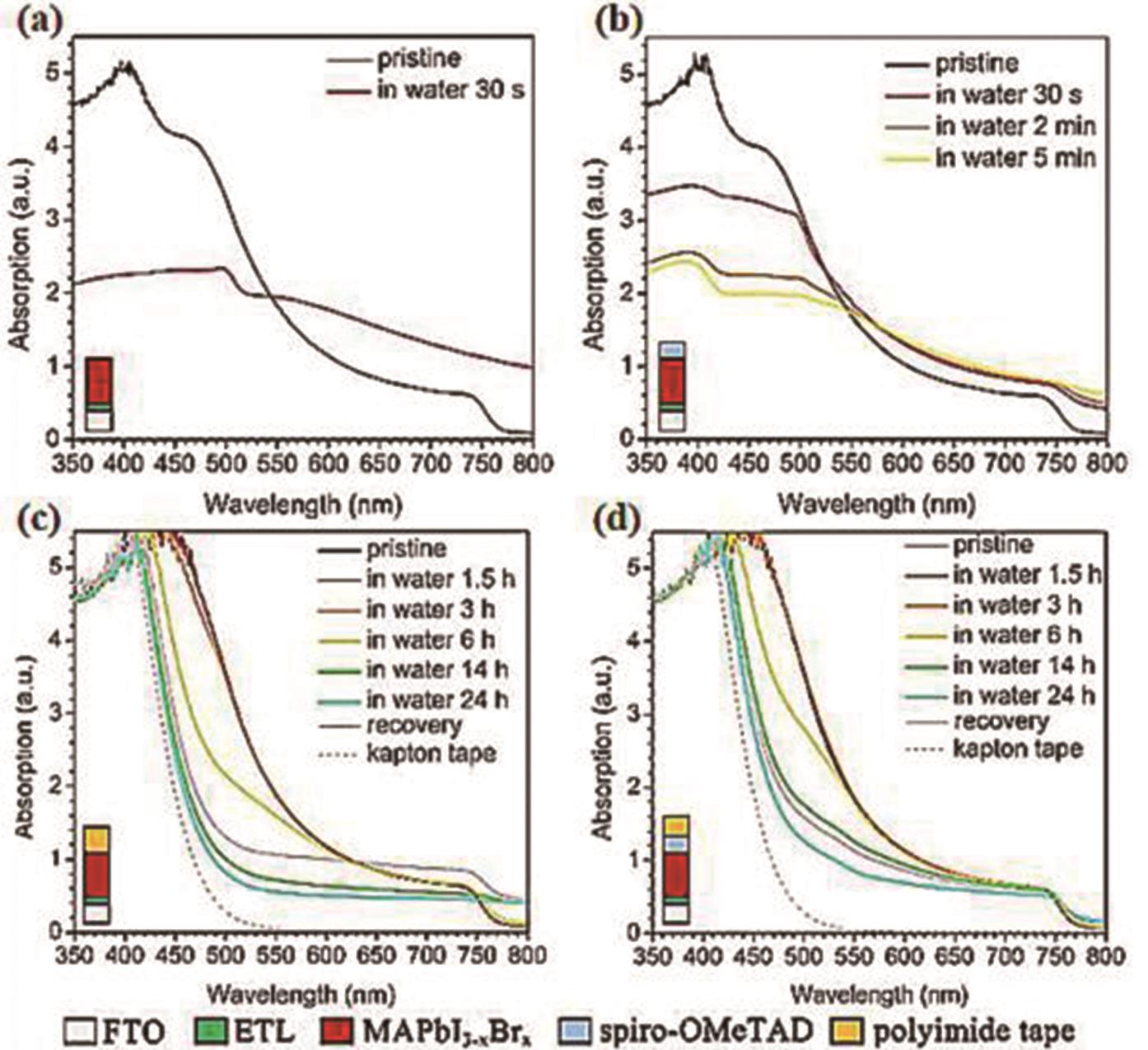
图33 在去离子水中浸泡不同时间后, (a)钙钛矿型薄膜; (b)钙钛矿薄膜/spiro-OMeTAD薄膜; (c)钙钛矿薄膜/聚酰亚胺带; (d)钙钛矿薄膜/spiro-OMeTAD薄膜/聚酰亚胺带的非原位紫外-可见吸收光谱[119]
Fig.33 Ex situ UV-Vis absorption spectra of perovskite film (a), perovskite/spiro-OMeTAD film (b), perovskite/PI tape film (c) and perovskite/spiro-OMeTAD/PI tape film (d) after immersion in DI water for different time[119]
| 1 | FROST J M, BUTLER K T, BRIVIO F, et al. Atomistic origins of high-performance in hybrid halide perovskite solar cells[J]. Nano Lett, 2014, 14(5): 2584-2590. |
| 2 | KOJIMA A, TESHIMA K, SHIRAI Y, et al. Organometal halide perovskites as visible-light sensitizers for photovoltaic cells[J]. J Am Chem Soc, 2009, 131(17): 6050-6051. |
| 3 | JEONG J, KIM M, SEO J, et al. Pseudo-halide anion engineering for α-FAPbI3 perovskite solar cells[J]. Nature, 2021, 592(7854): 381-385. |
| 4 | YE T, HOU Y, NOZARIASBMARZ A, et al. Cost-effective high-performance charge-carrier-transport-layer-free perovskite solar cells achieved by suppressing ion migration[J]. ACS Energy Lett, 2021, 6 (9): 3044-3052. |
| 5 | ZHOU Q, DUAN J, DU J, et al. Tailored lattice “tape” to confine tensile interface for 11.08%-efficiency all-inorganic CsPbBr3 perovskite solar cell with an ultrahigh voltage of 1.702 V[J]. Adv Sci (Weinh), 2021, 8(19): 2101418-2101426. |
| 6 | TONG G, SON D Y, ONO L K, et al. Removal of residual compositions by powder engineering for high efficiency formamidinium-based perovskite solar cells with operation lifetime over 2000 h[J]. Nano Energy, 2021, 87: 106152-106161. |
| 7 | ZHU J, PARK S, GONG O Y, et al. Formamidine disulfide oxidant as a localized electron scavenger for >20% perovskite solar cell modules[J]. Energy Environ Sci, 2021, 14(9): 4903-4914. |
| 8 | SHI L, BUCKNALL M P, YOUNG T L, et al. Gas chromatography-mass spectrometry analyses of encapsulated stable perovskite solar cells[J]. Science, 2020, 368(6497): eaba2412. |
| 9 | XIAO K, HAN Q, GAO Y, et al. Simultaneously enhanced moisture tolerance and defect passivation of perovskite solar cells with cross-linked grain encapsulation[J]. J Energy Chem, 2021, 56: 455-462. |
| 10 | JIANG Q, ZHANG L Q, WANG H L, et al. Enhanced electron extraction using SnO2 for high-efficiency planar-structure HC(NH2)2PbI3-based perovskite solar cells[J]. Nat Energy, 2016, 2(1): 1-7. |
| 11 | YANG D, ZHOU X, YANG R X, et al. Surface optimization to eliminate hysteresis for record efficiency planar perovskite solar cells[J]. Energy Environ Sci, 2016, 9(10): 3071-3078. |
| 12 | YOU J B, HONG Z, YANG Y M, et al. Low-temperature solution-processed perovskite solar cells with high efficiency and flexibility[J]. ACS Nano, 2014, 8(2): 1674-1680. |
| 13 | LIU D Y, KELLY T L. Perovskite solar cells with a planar heterojunction structure prepared using room-temperature solution processing techniques[J]. Nat Photonics, 2013, 8(2): 133-138. |
| 14 | MA S H, PANG S Z, DONG H, et al. Stability improvement of perovskite solar cells by the moisture-resistant PMMA: Spiro-OMeTAD hole transport layer[J]. Polymers, 2022, 14(2): 343-353. |
| 15 | HUANG C, LIU C J, DI Y X, et al. Efficient planar perovskite solar cells with reduced hysteresis and enhanced open circuit voltage by using PW12-TiO2 as electron transport layer[J]. ACS Appl Mater Interfaces, 2016, 8(13): 8520-8526. |
| 16 | BI D Q, TRESS W, DAR M I, et al. Efficient luminescent solar cells based on tailored mixed-cation perovskites[J]. Sci Adv, 2016, 2(1): e1501170-e1501170. |
| 17 | ALISHAH H M, CHOI F P G, KURUOGLU F, et al. Improvement of fill factor by the utilization of Zn-doped PEDOT∶PSS hole-transport layers for p-i-n planar type of perovskite solar cells[J]. Electrochim Acta, 2021, 388: 138658-138669. |
| 18 | DONG H, PANG S Z, ZHANG Y, et al. Improving electron extraction ability and device stability of perovskite solar cells using a compatible PCBM/AZO electron transporting bilayer[J]. Nanomaterials (Basel), 2018, 8(9): 720-729. |
| 19 | MENG L, SUN C K, WANG R, et al. Tailored phase conversion under conjugated polymer enables thermally stable perovskite solar cells with efficiency exceeding 21%[J]. J Am Chem Soc, 2018, 140(49): 17255-17262. |
| 20 | HU Y Q, SHAN Y S, YU Z L, et al. Incorporation of γ-aminobutyric acid and cesium cations to formamidinium lead halide perovskites for highly efficient solar cells[J]. J Energy Chem, 2022, 64: 561-567. |
| 21 | ZHANG J J, LI X H, WANG L X, et al. Enhanced performance of CH3NH3PbI3 perovskite solar cells by excess halide modification[J]. Appl Surf Sci, 2021, 564: 150464-150473. |
| 22 | LEE J W, KIM D H, KIM H S, et al. Formamidinium and cesium hybridization for photo- and moisture-stable perovskite solar cell[J]. Adv Energy Mater, 2015, 5(20): 1501310-1501318. |
| 23 | SALIBA M, MATSUI T, DOMANSKI K, et al. Incorporation of rubidium cations into perovskite solar cells improves photovoltaic performance[J]. Science, 2016, 354(6309): 206-209. |
| 24 | ORANSKAIA A, SCHWINGENSCHLÖGL U. Suppressing X-migrations and enhancing the phase stability of cubic FAPbX3(X=Br, I)[J]. Adv Energy Mater, 2019, 9(32): 1901411-1901422. |
| 25 | WEI Q, BI H, YAN S, et al. Morphology and interface engineering for organic metal halide perovskite-based photovoltaic cells[J]. Adv Mater Interfaces, 2018, 5(14): 1800248-1800264. |
| 26 | WANG S W, YAN S, WANG M, et al. Construction of nanowire CH3NH3PbI3-based solar cells with 17.62% efficiency by solvent etching technique[J]. Sol Energy Mater Sol Cells, 2017, 167: 173-177. |
| 27 | KONG W C, WANG S W, LI F, et al. Ultrathin perovskite monocrystals boost the solar cell performance[J]. Adv Energy Mater, 2020, 10(34): 2000453-2000460. |
| 28 | SONG T Y, GAO L F, WEI Q, et al. Study on the effect of chlorine on the growth of CH3NH3PbI3- xClx crystals[J]. Mater Res Express, 2020, 7(1): 015522-015527. |
| 29 | SONG T Y, BI H, WEI Q, et al. Study on the movements of organometallic halide perovskite crystals on their films[J]. ChemistrySelect, 2019, 4(47): 13904-13907. |
| 30 | LIU F Y, ZUO X K, WANG K, et al. Improving performance and stability of planar perovskite solar cells through passivation effect with green additives[J]. Solar RRL, 2021, 5(4): 2000732-2000742. |
| 31 | 李晓茵, 周传聪, 王英华, 等. 锡基钙钛矿太阳电池光吸收材料[J]. 化学进展, 2019, 31(6): 882-893. |
| LI X Y, ZHOU C C, WANG Y H, et al. Tin based perovskite solar cell light absorbing material[J]. Prog Chem, 2019, 31(6): 882-893. | |
| 32 | SAPAROV B, HONG F, SUN J P, et al. Thin-film preparation and characterization of Cs3Sb2I9: a leadfree layered perovskite semiconductor[J]. Chem Mater, 2015, 22(16): 5622-5632. |
| 33 | XU Z H, ZHANG C, YU F Y, et al. Synthesis of Sb(V) complexes with pyridyl cations and application for lead-free perovskite solar cells[J]. Chem Lett, 2020, 49(8): 944-946. |
| 34 | SHAO Z, LE MERCIER T, MADEC M B, et al. Exploring AgBixI3 x+1 semiconductor thin films for lead-free perovskite solar cells[J]. Mater Design, 2018, 141: 81-87. |
| 35 | ÖZ S, HEBIG J C, JUNG E, et al. Zero-dimensional (CH3NH3)3Bi2I9 perovskite for optoelectronic applications[J]. Sol Energy Mater Sol Cells, 2016, 158: 195-201. |
| 36 | SLAVNEY A H, HU T, LINDENBERG A M, et al. A bismuth-halide double perovskite with long carrier recombination lifetime for photovoltaic applications[J]. J Am Chem Soc, 2016, 138(7): 2138-2141. |
| 37 | JU M G, CHEN M, ZHOU Y Y, et al. Earth-abundant nontoxic titanium(Ⅳ)-based vacancy-ordered double perovskite halides with tunable 1.0 to 1.8 eV bandgaps for photovoltaic applications[J]. ACS Energy Lett, 2018, 3(2): 297-304. |
| 38 | HARIKESH P C, MULMUDI H K, GHOSH B, et al. Rb as an alternative cation for templating inorganic lead-free perovskites for solution processed photovoltaics[J]. Chem Mater, 2016, 28(20): 7496-7504. |
| 39 | KRISHNAMOORTHY T, DING H, YAN C, et al. Lead-free germanium iodide perovskite materials for photovoltaic applications[J]. J Mater Chem A, 2015, 3(47): 23829-23832. |
| 40 | CORTECCHIA D, DEWI H A, YIN J, et al. Lead-free MA2CuClxBr4- x hybrid perovskites[J]. Inorg Chem, 2016, 55(3): 1044-1052. |
| 41 | KIM J H, LIANG P W, WILLIAMS S T, et al. High-performance and environmentally stable planar heterojunction perovskite solar cells based on a solution-processed copper-doped nickel oxide hole-transporting layer[J]. Adv Mater, 2015, 27(4): 695-701. |
| 42 | LIU X, WU T H, CHEN J Y, et al. Templated growth of FASnI3 crystals for efficient tin perovskite solar cells[J]. Energy Environl Sci, 2020, 13(9): 2896-2902. |
| 43 | YANG Y, YOU J. Make perovskite solar cells stable[J]. Nature, 2017, 544(7649): 155-156. |
| 44 | LI W, ZHANG W, VAN REENEN S, et al. Enhanced UV-light stability of planar heterojunction perovskite solar cells with caesium bromide interface modification[J]. Energy Environ Sci, 2016, 9(2): 490-498. |
| 45 | NIU T Q, LU J, TANG M C, et al. High performance ambient-air-stable FAPbI3 perovskite solar cells with molecule-passivated Ruddlesden-Popper/3D heterostructured film[J]. Energy Environ Sci, 2018, 11(12): 3358-3366. |
| 46 | YOU J, MENG L, SONG T B, et al. Improved air stability of perovskite solar cells via solution-processed metal oxide transport layers[J]. Nat Nanotechnol, 2016, 11(1): 75-81. |
| 47 | HUANG J B, TAN S Q, LUND P D, et al. Impact of H2O on organic-inorganic hybrid perovskite solar cells[J]. Energy Environ Sci, 2017, 10(11): 2284-2311. |
| 48 | HU Y Q, QIU T, BAI F, et al. Enhancing moisture-tolerance and photovoltaic performances for FAPbI3 by bismuth incorporation[J]. J Mater Chem A, 2017, 5(48): 25258-25265. |
| 49 | KANG H, KIM G, KIM J, et al. Bulk-heterojunction organic solar cells: five core technologies for their commercialization[J]. Adv Mater, 2016, 28(36): 7821-7861. |
| 50 | YANG Y F, LUO J D, LUO N Q, et al. Effect of Cs+ fraction on photovoltaic performance of perovskite solar cells based on CsxMA1- xPbI3 absorption layers[J]. J Electron Mater, 2020, 49(12): 7044-7053. |
| 51 | RAMOS F J, CORTES D, AGUIRRE A, et al. Fabrication and encapsulation of perovskites sensitized solid state solar cells: 2014 IEEE 40th Photovoltaic Specialist Conference (PVSC)[C]. Denver, CO, USA: IEEE, 2014: 2584-2587. |
| 52 | JAGADAMMA L K, BLASZCZYK O, SAJJAD M T, et al. Efficient indoor p-i-n hybrid perovskite solar cells using low temperature solution processed NiO as hole extraction layers[J]. Sol Energy Mater Sol Cells, 2019, 201: 110071-110080. |
| 53 | DUALEH A, TETREAULT N, MOEHL T, et al. Effect of annealing temperature on film morphology of organic-inorganic hybrid pervoskite solid-state solar cells[J]. Adv Funct Mater, 2014, 24(21): 3250-3258. |
| 54 | BELLA F, GRIFFINI G, CORREA-BAENA J P, et al. Improving efficiency and stability of perovskite solar cells with photocurable fluoropolymers[J]. Science, 2016, 354(6309): 203-206. |
| 55 | KIM Y, KIM H, GRAHAM S, et al. Durable polyisobutylene edge sealants for organic electronics and electrochemical devices[J]. Sol Energy Mater Sol Cells, 2012, 100: 120-125. |
| 56 | LI J L, XIA R, QI W J, et al. Encapsulation of perovskite solar cells for enhanced stability: structures, materials and characterization[J]. J Power Sources, 2021, 485: 229313-229327. |
| 57 | CHANG C Y, CHOU C T, LEE Y J, et al. Thin-film encapsulation of polymer-based bulk-heterojunction photovoltaic cells by atomic layer deposition[J]. Org Electron, 2009, 10(7): 1300-1306. |
| 58 | HUANG Z Q, LONG J, DAI R Y, et al. Ultra-flexible and waterproof perovskite photovoltaics for washable power source applications[J]. Chem Commun, 2021, 57(51): 6320-6323. |
| 59 | JIANG Q, ZHAO Y, ZHANG X W, et al. Surface passivation of perovskite film for efficient solar cells[J]. Nat Photonics, 2019, 13(7): 460-466. |
| 60 | CHOI J M, SUKO H, KIM K, et al. Multi-walled carbon nanotube-assisted encapsulation approach for stable perovskite solar cells[J]. Molecules, 2021, 26(16): 5060-5069. |
| 61 | ANGMO D, GEVORGYAN S A, LARSEN-OLSEN T T, et al. Scalability and stability of very thin, roll-to-roll processed, large area, indium-tin-oxide free polymer solar cell modules[J]. Org Electron, 2013, 14(3): 984-994. |
| 62 | MATTEOCCI F, CINA L, LAMANNA E, et al. Encapsulation for long-term stability enhancement of perovskite solar cells[J]. Nano Energy, 2016, 30: 162-172. |
| 63 | SHI L, YOUNG T L, KIM J, et al. Accelerated lifetime testing of organic-inorganic perovskite solar cells encapsulated by polyisobutylene[J]. ACS Appl Mater Interfaces, 2017, 9(30): 25073-25081. |
| 64 | CHEACHAROEN R, BOYD C C, BURKHARD G F, et al. Encapsulating perovskite solar cells to withstand damp heat and thermal cycling[J]. Sustainable Energy Fuels, 2018, 2(11): 2398-2406. |
| 65 | BUSH K A, PALMSTROM A F, YU Z J, et al. 23.6%-efficient monolithic perovskite/silicon tandem solar cells with improved stability[J]. Nat Energy, 2017, 2(4): 1-7. |
| 66 | LIU W S, WANG Z G. Comparative study of silicon-containing cycloaliphatic epoxides between different chemical structures and curing mechanisms for potential light-emitting diode encapsulation applications[J]. Polym Int, 2013, 62(3): 512-522. |
| 67 | DONG Q, LIU F, WONG M K, et al. Encapsulation of perovskite solar cells for high humidity conditions[J]. ChemSusChem, 2016, 9(18): 2597-2603. |
| 68 | MA S, BAI Y, WANG H, et al. 1000 h operational lifetime perovskite solar cells by ambient melting encapsulation[J]. Adv Energy Mater, 2020, 10(9): 1902472-1902479. |
| 69 | RAMASAMY E, KARTHIKEYAN V, RAMESHKUMAR K, et al. Glass-to-glass encapsulation with ultraviolet light curable epoxy edge sealing for stable perovskite solar cells[J]. Mater Lett, 2019: 25051-25054. |
| 70 | MARTINS J, EMAMI S, MADUREIRA R, et al. Novel laser-assisted glass frit encapsulation for long-lifetime perovskite solar cells[J]. J Mater Chem A, 2020, 8(38): 20037-20046. |
| 71 | WEERASINGHE H C, DKHISSI Y, SCULLY A D, et al. Encapsulation for improving the lifetime of flexible perovskite solar cells[J]. Nano Energy, 2015, 18: 118-125. |
| 72 | BONOMO M, TAHERI B, BONANDINI L, et al. Thermosetting polyurethane resins as low-cost, easily scalable, and effective oxygen and moisture barriers for perovskite solar cells[J]. ACS Appl Mater Interfaces, 2020, 12(49): 54862-54875. |
| 73 | PARK H H. Inorganic materials by atomic layer deposition for perovskite solar cells[J]. Nanomaterials, 2021, 11(1): 88-108. |
| 74 | SAMADPOUR M, HEYDARI M, MOHAMMADI M, et al. Water repellent room temperature vulcanized silicone for enhancing the long-term stability of perovskite solar cells[J]. Solar Energy, 2021, 218: 28-34. |
| 75 | HUANG Z Q, HU X T, LIU C, et al. Water-resistant and flexible perovskite solar cells via a glued interfacial layer[J]. Adv Funct Mater, 2019, 29(37): 1902629-1902636. |
| 76 | YOO J S, HAN G S, LEE S, et al. Dual function of a high-contrast hydrophobic-hydrophilic coating for enhanced stability of perovskite solar cells in extremely humid environments[J]. Nano Res, 2017, 10(11): 3885-3895. |
| 77 | ORESKI G, OMAZIC A, EDER G C, et al. Properties and degradation behaviour of polyolefin encapsulants for photovoltaic modules[J]. Prog Photovoltaics: Res Appl, 2020, 28(12): 1277-1288. |
| 78 | KEMPE M D, PANCHAGADE D, REESE M O, et al. Modeling moisture ingress through polyisobutylene-based edge-seals[J]. Prog Photovoltaics: Res Appl, 2015, 23(5): 570-581. |
| 79 | ASLAN E, ATES TURKMEN T, ALTURK E. High stability perovskite solar cells under ambient conditions[J]. IET Renewable Power Generation, 2020, 14(16): 3160-3163. |
| 80 | KEMPE M D, JORGENSEN G J, TERWILLIGER K M, et al. Acetic acid production and glass transition concerns with ethylene-vinyl acetate used in photovoltaic devices[J]. Sol Energy Mater Sol Cells, 2007, 91(4): 315-329. |
| 81 | SOO Y H, NG S A, WONG Y H, et al. Thermal stability enhancement of perovskite MAPbI3 film at high temperature (150 ℃) by PMMA encapsulation[J]. J Mater Sci Mater Electron, 2021, 32(11): 14885-14900. |
| 82 | CASTRO-HERMOSA S, TOP M, DAGAR J, et al. Quantifying performance of permeation barrier-encapsulation systems for flexible and glass-based electronics and their application to perovskite solar cells[J]. Adv Electronic Mater, 2019, 5(10): 1800978-1800988. |
| 83 | SHI J D, GE W Y, GAO W X, et al. Enhanced thermal stability of halide perovskite CsPbX3 nanocrystals by a facile TPU encapsulation[J]. Adv Optical Mater, 2019, 8(4): 1901516-1901524. |
| 84 | WU J H, CUI Y Q, YU B C, et al. A simple way to simultaneously release the interface stress and realize the inner encapsulation for highly efficient and stable perovskite solar cells[J]. Adv Funct Mater, 2019, 29(49): 1905336-1905346. |
| 85 | BI H, LIU F Y, WANG M, et al. Construction of ultra-stable perovskite-polymer fibre membranes by electrospinning technology and its application to light-emitting diodes[J]. Polym Int, 2020, 70(1): 90-95. |
| 86 | JIANG Y, QIU L B, JUAREZ-PEREZ E J, et al. Reduction of lead leakage from damaged lead halide perovskite solar modules using self-healing polymer-based encapsulation[J]. Nat Energy, 2019, 4(7): 585-593. |
| 87 | MCKENNA B, TROUGHTON J R, WATSON T M, et al. Enhancing the stability of organolead halide perovskite films through polymer encapsulation[J]. RSC Adv, 2017, 7(52): 32942-32951. |
| 88 | KIM H, LEE J, KIM B, et al. Enhanced stability of MAPbI3 perovskite solar cells using poly(p-chloro-xylylene) encapsulation[J]. Sci Rep, 2019, 9(1): 1-6. |
| 89 | FU Z Y, XU M, SHENG Y S, et al. Encapsulation of printable mesoscopic perovskite solar cells enables high temperature and long-term outdoor stability[J]. Adv Funct Mater, 2019, 29(16): 1809129-1809135. |
| 90 | DENG K M, LIU Z Z, XIN Y, et al. PbI2/CH3NH3Cl mixed precursor-induced micrometer-scale grain perovskite film and room-temperature film encapsulation toward high efficiency and stability of planar perovskite solar cells[J]. Adv Mater Interfaces, 2018, 5(15): 1800499-1800506. |
| 91 | IDIGORAS J, APARICIO F J, CONTRERAS-BERNAL L, et al. Enhancing moisture and water resistance in perovskite solar cells by encapsulation with ultrathin plasma polymers[J]. ACS Appl Mater Interfaces, 2018, 10(14): 11587-11594. |
| 92 | WEN X R, WU J M, YE M D, et al. Interface engineering via an insulating polymer for highly efficient and environmentally stable perovskite solar cells[J]. Chem Commun, 2016, 52(76): 11355-11358. |
| 93 | HWANG I, JEONG I, LEE J, et al. Enhancing stability of perovskite solar cells to moisture by the facile hydrophobic passivation[J]. ACS Appl Mater Interfaces, 2015, 7(31): 17330-17336. |
| 94 | CHEN S S, DENG Y H, XIAO X, et al. Preventing lead leakage with built-in resin layers for sustainable perovskite solar cells[J]. Nat Sustain, 2021, 4(7): 636-643. |
| 95 | LIU Z Y, SUN B, SHI T L, et al. Enhanced photovoltaic performance and stability of carbon counter electrode based perovskite solar cells encapsulated by PDMS[J]. J Mater Chem A, 2016, 4(27): 10700-10709. |
| 96 | FUMANI N M R, ROGHABADI F A, ALIDAEI M, et al. Prolonged lifetime of perovskite solar cells using a moisture-blocked and temperature-controlled encapsulation system comprising a phase change material as a cooling agent[J]. ACS Omega, 2020, 5(13): 7106-7114. |
| 97 | JANG J H, KIM B J, KIM J H, et al. A novel approach for the development of moisture encapsulation poly(vinyl alcohol-co-ethylene) for perovskite solar cells[J]. ACS Omega, 2019, 4(5): 9211-9218. |
| 98 | PARK C, CHOI J, MIN J, et al. Suppression of oxidative degradation of tin-lead hybrid organometal halide perovskite solar cells by Ag doping[J]. ACS Energy Lett, 2020, 5(10): 3285-3294. |
| 99 | GHOSH S, SINGH R, SUBBIAH A S, et al. Enhanced operational stability through interfacial modification by active encapsulation of perovskite solar cells[J]. Appl Phys Lett, 2020, 116(11): 113502-113507. |
| 100 | CHOI E Y, KIM J, LIM S, et al. Enhancing stability for organic-inorganic perovskite solar cells by atomic layer deposited Al2O3 encapsulation[J]. Sol Energy Mater Sol Cells, 2018, 188: 37-45. |
| 101 | RAMOS F J, MAINDRON T, BÉCHU S, et al. Versatile perovskite solar cell encapsulation by low-temperature ALD-Al2O3 with long-term stability improvement[J]. Sustain Energy Fuels, 2018, 2(11): 2468-2479. |
| 102 | CHANG C Y, LEE K T, HUANG W K, et al. High-performance, air-stable, low-temperature processed semitran-sparent perovskite solar cells enabled by atomic layer deposition[J]. Chem Mater, 2015, 27(14): 5122-5130. |
| 103 | WANG H R, ZHAO Y P, WANG Z Y, et al. Hermetic seal for perovskite solar cells: an improved plasma enhanced atomic layer deposition encapsulation[J]. Nano Energy, 2020, 69: 104375-104383. |
| 104 | WONG-STRINGER M, GAME O S, SMITH J A, et al. High-performance multilayer encapsulation for perovskite photovoltaics[J]. Adv Energy Mater, 2018, 8(24): 1801234-1801244. |
| 105 | LEE Y I, JEON N J, KIM B J, et al. A low-temperature thin-film encapsulation for enhanced stability of a highly efficient perovskite solar cell[J]. Adv Energy Mater, 2018, 8(9): 1701928-1701935. |
| 106 | KIM B J, JANG J H, KIM J, et al. Efficiency and stability enhancement of organic-inorganic perovskite solar cells through micropatterned norland optical adhesive and polyethylene terephthalate encapsulation[J]. Mater Today Commun, 2019, 20: 100537-100543. |
| 107 | LV Y F, ZHANG H, LIU R Q, et al. Composite encapsulation enabled superior comprehensive stability of perovskite solar cells[J]. ACS Appl Mater Interfaces, 2020, 12(24): 27277-27285. |
| 108 | ZHAO O, DING Y, PAN Z, et al. Open-air plasma-deposited multilayer thin-film moisture barriers[J]. ACS Appl Mater Interfaces, 2020, 12(23): 26405-26412. |
| 109 | 盖德化工网. 美国进口低凝胶Surlyn1702-1沙林树脂[EB/OL]. (2021-12-31) [2021-12-31]. https://china.guidechem.com/trade/pdetail7863598.html. |
| Guide chemical network. Low gel Surlyn1702-1 sarin resin imported from USA[EB/OL]. (2021-12-31) [2021-12-31]. https://china.guidechem.com/trade/pdetail7863598.html. | |
| 110 | 盖德化工网. POE美国杜邦8150[EB/OL]. (2021-12-31) [2021-12-31]. https://china.guidechem.com/trade/pdetail22628271.html. |
| Guide chemical network. Poe DuPont 8150[EB/OL]. (2021-12-31) [2021-12-31]. https://china.guidechem.com/trade/pdetail22628271.html. | |
| 111 | 中国供应商. 高弹性耐热聚氨酯高透明TPU德国拜耳460热熔塑胶[EB/OL]. (2021-12-31) [2021-12-31]. https://www.china.cn/tpu/4776071144.html. |
| Chinese supplier. High elastic heat-resistant polyurethane high transparent TPU Germany Bayer 460 hot melt plastic[EB/OL]. (2021-12-31) [2021-12-31]. https://www.china.cn/tpu/4776071144.html. | |
| 112 | EMAMI S, MARTINS J, IVANOU D, et al. Advanced hermetic encapsulation of perovskite solar cells: the route to commercialization[J]. J Mater Chem A, 2020, 8(5): 2654-2662. |
| 113 | MENG X C, CAI Z R, ZHANG Y Y, et al. Bio-inspired vertebral design for scalable and flexible perovskite solar cells[J]. Nat Commun, 2020, 11(1): 1-10. |
| 114 | PANDEY M, KAPIL G, SAKAMOTO K, et al. Efficient, hysteresis free, inverted planar flexible perovskite solar cells via perovskite engineering and stability in cylindrical encapsulation[J]. Sustain Energy Fuels, 2019, 3(7): 1739-1748. |
| 115 | LIU T H, ZHOU Y Y, LI Z, et al. Stable formamidinium-based perovskite solar cells via in situ grain encapsulation[J]. Adv Energy Mater, 2018, 8(22): 1800232-1800240. |
| 116 | ZHAO J, BRINKMANN K O, HU T, et al. Self-encapsulating thermostable and air-resilient semitransparent perovskite solar cells[J]. Adv Energy Mater, 2017, 7(14): 1602599-1602606. |
| 117 | YIN J, CUI J W, ZHOU H W, et al. Encapsulation of UV glue, hydrophobicity of binder and carbon electrode enhance the stability of organic-inorganic hybrid perovskite solar cells up to 5 years[J]. Energy Technol, 2020, 8(11): 2000513-2000517. |
| 118 | AN M W, XING Z, WU B S, et al. Cross-linkable fullerene interfacial contacts for enhancing humidity stability of inverted perovskite solar cells[J]. Rare Met, 2020, 40(7): 1691-1697. |
| 119 | LI B, WANG M, SUBAIR R, et al. Significant stability enhancement of perovskite solar cells by facile adhesive encapsulation[J]. J Phys Chem C, 2018, 122(44): 25260-25267. |
| [1] | 焦陈斯帆, 郑少波, 许鹏军, 王炜, Takebe Hiromichi, Mukai Kusuhiro, 余仲达. 评价表面活性剂溶液泡沫性能的方法—真球气泡法[J]. 应用化学, 2022, 39(7): 1108-1118. |
| [2] | 徐众, 李军, 吴恩辉, 蒋燕. 添加提钒尾渣对膨胀石墨/石蜡复合相变材料稳定性和导电性的影响[J]. 应用化学, 2022, 39(3): 461-469. |
| [3] | 杜新伟, 赵文杰, 呼微, 孙昭艳, 刘万利, 任天磊, 付明星. 聚醚醚酮/碳纳米管改性聚丙烯Janus复合隔膜的制备及性能[J]. 应用化学, 2022, 39(12): 1862-1869. |
| [4] | 李赫, 李宫, 宫雪, 阮明波, 韩策, 宋平, 徐维林. Pt/C催化剂长时间ORR过程性能衰减的机理[J]. 应用化学, 2022, 39(10): 1564-1571. |
| [5] | 赵常利, 秦明高, 窦晓秋, 冯传良. 纳米颗粒增强的手性超分子水凝胶成骨性能[J]. 应用化学, 2022, 39(1): 177-187. |
| [6] | 赵莹, 邵奕嘉, 李罗钱, 任建伟, 廖世军. 富锂正极材料的衰减机理及循环稳定性提升的研究进展[J]. 应用化学, 2022, 39(02): 205-222. |
| [7] | 乔宗文, 陈涛. 具有高效长侧链的芘磺酸型磺化聚砜阳离子交换膜的性能[J]. 应用化学, 2021, 38(6): 668-674. |
| [8] | 吴振江, 霍晓伟, 刘守军, 杨颂. 水性颜料体系无树脂色浆的制备与应用[J]. 应用化学, 2021, 38(2): 212-219. |
| [9] | 朱梦梦, 白珏垚, 陈人杰, 李会利. B位离子掺杂全无机钙钛矿量子点的合成及性能研究进展[J]. 应用化学, 2021, 38(12): 1541-1555. |
| [10] | 王森, 庞然, 李达, 李成宇, 张洪杰. 单一基质白光荧光粉Na3Sc2(PO4)3∶Tm3+,Dy3+的合成及发光性质[J]. 应用化学, 2021, 38(11): 0-0. |
| [11] | 王森, 庞然, 李达, 李成宇, 张洪杰. 单一基质白光荧光粉Na3Sc2(PO4)3∶Tm3+,Dy3+的合成及发光性质[J]. 应用化学, 2021, 38(11): 1469-1478. |
| [12] | 曹友錋, 庞烜, 项盛, 王天昶, 冯立栋, 边新超, 李杲, 陈学思. 溶剂诱导的聚乳酸/聚乳酸衍生物共结晶行为[J]. 应用化学, 2021, 38(1): 60-68. |
| [13] | 乔宗文, 赵本波. 基于一锅法的磺化聚砜质子交换膜的性能[J]. 应用化学, 2020, 37(6): 658-665. |
| [14] | 安露露, 米杰. 镍钴氢氧化物的制备及其电化学性能[J]. 应用化学, 2020, 37(5): 579-586. |
| [15] | 文璞山, 何瑞, 赵光练, 梁兴, 李明勳. 可溶性聚酰亚胺液晶取向膜的制备与性能[J]. 应用化学, 2020, 37(12): 0-0. |
| 阅读次数 | ||||||
|
全文 |
|
|||||
|
摘要 |
|
|||||
